 China`s Crimson Typhoon faces off against a Kaiju, code name Otachi in Warner Bros. Pictures` and Legendary Pictures` sci-fi action adventure PACIFIC RIM, a Warner Bros. Pictures release. Photo courtesy of Warner Bros. Pictures. © 2013 WARNER BROS. ENTERTAINMENT INC. AND LEGENDARY PICTURES FUNDING, LLC
China`s Crimson Typhoon faces off against a Kaiju, code name Otachi in Warner Bros. Pictures` and Legendary Pictures` sci-fi action adventure PACIFIC RIM, a Warner Bros. Pictures release. Photo courtesy of Warner Bros. Pictures. © 2013 WARNER BROS. ENTERTAINMENT INC. AND LEGENDARY PICTURES FUNDING, LLCPhotos and Information for Upcoming Giant Monster Movie Source: Warner Bros. Entertainment Inc. Official Site: pacificrimmovie.warnerbros.com
SPOILER WARNING: This article contains plot details and images from an upcoming movie.
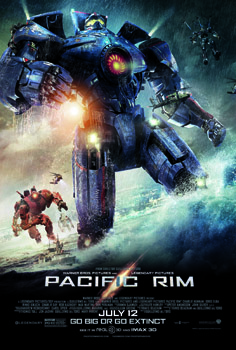 PACIFIC RIM poster, courtesy of Warner Bros. Pictures. © 2013 WARNER BROS. ENTERTAINMENT INC. AND LEGENDARY PICTURES FUNDING, LLC
PACIFIC RIM poster, courtesy of Warner Bros. Pictures. © 2013 WARNER BROS. ENTERTAINMENT INC. AND LEGENDARY PICTURES FUNDING, LLCFrom acclaimed filmmaker Guillermo del Toro comes the sci-fi action adventure “Warner Bros. Pictures and Legendary Pictures Pacific Rim.” When legions of monstrous creatures, known as Kaiju, started rising from the sea, a war began that would take millions of lives and consume humanity’s resources for years on end. To combat the giant Kaiju, a special type of weapon was devised: massive robots, called Jaegers, which are controlled simultaneously by two pilots whose minds are synched via a neural bridge, called “The Drift.” But as the enemy grows more powerful with each attack, even the Jaegers are proving nearly defenseless in the face of the relentless Kaiju. On the verge of defeat, the forces defending mankind have no choice but to turn to two unlikely heroes -- a washed up former pilot (Charlie Hunnam) and an untested trainee (Rinko Kikuchi) -- who are teamed to drive a seemingly obsolete Jaeger. Together, they stand as mankind’s last hope against the mounting apocalypse. Oscar nominee Guillermo del Toro (“Pan’s Labyrinth”) directed the epic sci-fi action adventure from a script by Travis Beacham and del Toro, story by Beacham. Thomas Tull, Jon Jashni, del Toro and Mary Parent produced the film, with Callum Greene serving as executive producer and Jillian Zaks co-producing. “Pacific Rim” stars Charlie Hunnam (TV’s “Sons of Anarchy”), Idris Elba (“Thor”), Oscar nominee Rinko Kikuchi (“Babel”), Charlie Day (“Horrible Bosses”), Rob Kazinsky, Max Martini, Clifton Collins, Jr., Burn Gorman, and Ron Perlman (the “Hellboy” films). Del Toro’s behind-the-scenes team included Academy Award®-winning director of photography Guillermo Navarro (“Pan’s Labyrinth”), production designers Andrew Neskoromny and Carol Spier, editors Peter Amundson and John Gilroy, and costume designer Kate Hawley. The music is composed by Ramin Djawadi. The visual effects supervisors are John Knoll and James E. Price and the animation supervisor is Hal Hickel. Warner Bros. Pictures and Legendary Pictures present a Legendary Pictures/DDY Production, a Guillermo del Toro film. The film will be released in 2D and 3D in select theaters and IMAX, and will be distributed worldwide by Warner Bros. Pictures, a Warner Bros. Entertainment Company. This film has been rated PG-13 for sequences of intense sci-fi action and violence throughout, and brief language.
 A Kaiju attacks Sydney Harbour. Photo courtesy of Warner Bros. Pictures. © 2013 WARNER BROS. ENTERTAINMENT INC. AND LEGENDARY PICTURES FUNDING, LLC
A Kaiju attacks Sydney Harbour. Photo courtesy of Warner Bros. Pictures. © 2013 WARNER BROS. ENTERTAINMENT INC. AND LEGENDARY PICTURES FUNDING, LLCABOUT THE PRODUCTION
KAIJU (kaij?, Japanese) Giant Beast. JAEGER (y?’gar, German) Hunter. “When I was a kid, whenever I’d feel small or lonely, I’d look up at the stars and wonder if there was life up there. Turns out, I was looking in the wrong direction.” The depths of the ocean have always held a fascination for people, but we have always assumed that its wonders—and its dangers—are of our own world. We were wrong. That intriguing premise gave rise to “Warner Bros. Pictures & Legendary Pictures Pacific Rim.” As the film begins, a breach in the floor of the Pacific Ocean unleashes a cataclysmic threat to the human race.
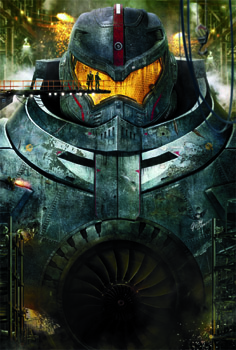 Textless promotional artwork, courtesy of Warner Bros. Pictures. © 2013 WARNER BROS. ENTERTAINMENT INC. AND LEGENDARY PICTURES FUNDING, LLC
Textless promotional artwork, courtesy of Warner Bros. Pictures. © 2013 WARNER BROS. ENTERTAINMENT INC. AND LEGENDARY PICTURES FUNDING, LLCDirector Guillermo del Toro, who also co-wrote and served as a producer on the film, relates, “Through that portal come creatures that are larger and more ferocious and brutal than anything we have ever seen: the Kaiju. In order to grapple with them, mankind pulls together all its resources and invents the largest, most dynamic and most versatile weapon ever devised. They create the Jaeger Program -- towering 25-story-high robots, each operated by two pilots whose minds are neurally linked together.” He continues, “It was a project that encompassed every single thing on my wish list, visually, atmospherically and emotionally... an unstoppable, thrilling adventure about monsters and robots, the likes of which we’ve never seen.” Producer Thomas Tull offers, “Just that description, ‘giant monsters versus giant robots,’ gives you a sense of the scope and scale, not to mention the action and fun. And there is also an element of mystery in that we don’t know why the Kaiju are attacking. What do they want and how is humanity going to react? How can we possibly defend ourselves against them?” The story originated with screenwriter Travis Beacham, who was on the actual Pacific Rim -- on the coast of California -- when the central elements of the film began to take shape. He recounts, “I remember walking along the beach in Santa Monica. It was a particularly foggy morning and there was something about the shape of the pier in the fog jutting out into the water... An image just kind of popped into my head of a behemoth, a monster, rising from the surf to meet this giant robot waiting on the shore to do battle. “However,” Beacham acknowledges, “I knew that by itself was not a story. What really crystallized the plot for me was figuring out who is driving the robot, and finally determining it had to be two pilots -- two people whose minds would have to be intimately connected to control this massive thing. That’s when the pieces started to fall into place in a very organic way.”
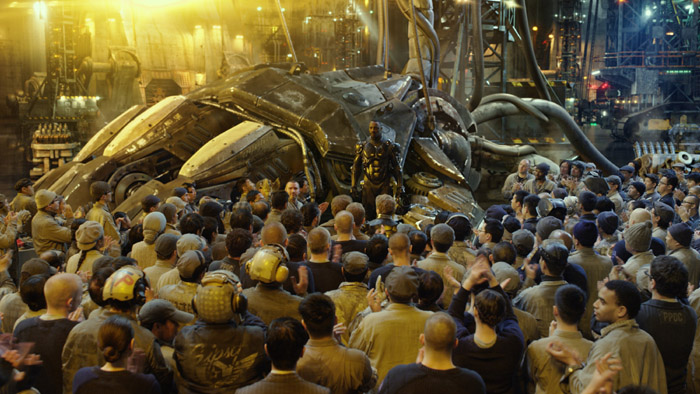 Idris Elba (center) as Stacker Pentecost. Photo courtesy of Warner Bros. Pictures. © 2013 WARNER BROS. ENTERTAINMENT INC. AND LEGENDARY PICTURES FUNDING, LLC
Idris Elba (center) as Stacker Pentecost. Photo courtesy of Warner Bros. Pictures. © 2013 WARNER BROS. ENTERTAINMENT INC. AND LEGENDARY PICTURES FUNDING, LLCAfter collaborating with producers Thomas Tull and Jon Jashni as a screenwriter on “Clash of the Titans,” Beacham told them about his original idea for a winner-take-all war that joins man and machine against aliens, who don’t invade from beyond our galaxy, but rather ascend from the deep. “I was hooked from the first moment Travis pitched it to us,” Tull recalls. “The film is about humanity being up against something unexpected and utterly overwhelming, and how they have to come together to combat it. We also thought the notion that we could be invaded from within was a very cool concept.” “You can’t really run from it because they are coming from a place that’s inescapably on Earth,” Beacham adds. “Part of the allure of the ocean is that it hides its secrets so well. There are so many myths about sea monsters and giant serpents and all the other things people suppose are down there. I think there is something elementally terrifying about what can come out of this blackness.”
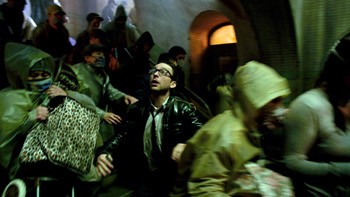 Charlie Day as Dr. Newton Geiszler. Photo courtesy of Warner Bros. Pictures. © 2013 WARNER BROS. ENTERTAINMENT INC. AND LEGENDARY PICTURES FUNDING, LLC
Charlie Day as Dr. Newton Geiszler. Photo courtesy of Warner Bros. Pictures. © 2013 WARNER BROS. ENTERTAINMENT INC. AND LEGENDARY PICTURES FUNDING, LLCGiven the enormity of the threat, “the stakes are huge for the entire planet,” Jashni says. “But starting with such huge stakes means you also have to find a way to make it more relatable on a personal level. The ability to reduce everything down to the emotional core is one of Guillermo del Toro’s many gifts... not to mention he is a master of the genre. He is encyclopedic about the Kaiju and ‘mecha’ cultures, making him uniquely qualified to capture the most accessible and entertaining facets of both. When we shared with him what we were cooking up with Travis, he was immediately on board.” As del Toro began crafting the screenplay with Beacham, he became totally immersed in the world they were forming. He attests, “The more we developed the universe, the more I became personally invested in the story, the characters, the monsters, the robots, and everything it would take to make it all real. I couldn’t wait.” “Working with Guillermo is incredible,” Beacham remarks. “He bristles with ideas and can come up with the most brilliant strokes of insight at the drop of a hat. He also loves monster movies, so we were definitely playing in his sandbox,” he laughs. “He came at the project with a genuine passion for the material, which I think was vital to the soul of the movie.” Del Toro’s enthusiasm was not only contagious to everyone involved in the film, but is also largely the reason he has become an unequivocal favorite among genre fans. In fact, he would be the first to count himself among those collectively known as “fanboys.” Producer Mary Parent says, “Guillermo has a special connection to that audience because he is that audience, and that makes a huge difference. He is just as excited about creating these amazing worlds as we are to see them. You know, going in, he’s going to deliver a visceral, thrilling rollercoaster.”
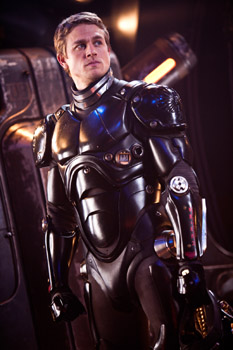 Charlie Hunnam as Raleigh Becket. Photo courtesy of Warner Bros. Pictures. © 2013 WARNER BROS. ENTERTAINMENT INC. AND LEGENDARY PICTURES FUNDING, LLC
Charlie Hunnam as Raleigh Becket. Photo courtesy of Warner Bros. Pictures. © 2013 WARNER BROS. ENTERTAINMENT INC. AND LEGENDARY PICTURES FUNDING, LLCNevertheless, it was essential to the filmmakers that the magnitude of the action be balanced with the human stories that are at the heart of the film. Jashni notes, “A core theme of the movie is the indomitability of the human spirit, no matter how titanic the threat.” Charlie Hunnam, who stars as Raleigh Becket, one of the brave Jaeger pilots, says, “The characters in the film are at the eleventh hour, and the only way they can overcome this colossal danger is by coming together and forgetting all their petty differences, be it nations or creeds or backgrounds. The one thing mankind has proven time and time again is that we can overcome any obstacle that we set our minds to, and I think that message will resonate with audiences.” The global nature of the war against the Kaiju is reflected in the design, colors and insignia of the Jaegers, all giving nods to their country of origin. The four main Jaegers seen battling in the film are: Gipsy Danger, from the USA; the Chinese Crimson Typhoon; Russia’s Cherno Alpha; and Striker Eureka, from Australia. No less attention was paid to the creation of the dreaded Kaiju, which are destruction incarnate. Del Toro assembled some of the top concept artists in the industry to design what he calls “the most terrifying but majestic creatures you could ever imagine,” each with its own distinct silhouette and lethal capabilities. The Jaegers and the Kaiju were brought to life onscreen by the visual effects wizards at the renowned Industrial Light & Magic (ILM), who were collaborating with del Toro for the first time. Together they executed epic battles that unfold on land and sea and in the air. The film also features an international cast, led by Hunnam and also starring Idris Elba, Rinko Kikuchi, Charlie Day, Rob Kazinsky, Max Martini, Clifton Collins, Jr., Burn Gorman, and Ron Perlman. “We want people to be taken by the spectacle and the sound and fury,” del Toro says, “but it is all meant to illuminate the courage of the central characters. Physically, the human beings are the smallest thing in the movie, but their spirit is the largest thing in the movie. They show you the makings of real heroes.” The expanse of the production took up every soundstage at Toronto’s Pinewood Studios, including two of the largest shooting stages in the world. One set, called the Conn-pod, was constructed on a large gimbal to make the actors -- outfitted in specialized suits created by Legacy Effects -- actually feel like they were engaged in battle. “We wanted to put the audience right there in the pilot seat. It will make you feel what it is to suit up, hook up, and take the robot for a ride.”
 Rinko Kikuchi as Mako Mori. Photo courtesy of Warner Bros. Pictures. © 2013 WARNER BROS. ENTERTAINMENT INC. AND LEGENDARY PICTURES FUNDING, LLC
Rinko Kikuchi as Mako Mori. Photo courtesy of Warner Bros. Pictures. © 2013 WARNER BROS. ENTERTAINMENT INC. AND LEGENDARY PICTURES FUNDING, LLCCAST
“Today, at the edge of our hope, at the end of our time, we’ve chosen to believe in each other.” Del Toro emphasizes, “The robot is only as good a fighter as the fighters inside. Ultimately, the most important dynamic that determines who pilots the Jaegers, and how effective they’ll be, is the relationship between the people.”
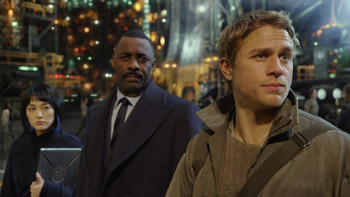 Rinko Kikuchi as Mako Mori, Idris Elba as Stacker Pentecost and Charlie Hunnam as Raleigh Becket. Photo courtesy of Warner Bros. Pictures. © 2013 WARNER BROS. ENTERTAINMENT INC. AND LEGENDARY PICTURES FUNDING, LLC
Rinko Kikuchi as Mako Mori, Idris Elba as Stacker Pentecost and Charlie Hunnam as Raleigh Becket. Photo courtesy of Warner Bros. Pictures. © 2013 WARNER BROS. ENTERTAINMENT INC. AND LEGENDARY PICTURES FUNDING, LLCEarly in the Jaeger program, it was discovered that the complexity and sheer size of the robots made it impossible for one person to handle alone. The neural load proved fatal for a single brain. Eventually, they learned that it could only be done with two pilots: one controlling the Jaeger’s right hemisphere; the other, the left. But in order for that to work, they had to be in perfect sync -- connected to the robot in body, and to each other in mind. That mental fusion is known as “The Drift.” Parent says, “Going into The Drift opens up all the channels of your brain. Suddenly, you have someone else in your head who is privy to every thought, every memory, every emotion.” Del Toro adds, “They become one unit, fused with each other and with the machine. But in order to do that, you have to be prepared to let somebody literally peek into your mind... into your soul.” “In The Drift, memories flood in and secrets come out,” says Beacham. “I think most people would have a natural reticence to let someone else into their brain. But Jaeger pilots need to bond instantly; that’s the only way it works. So they learned it’s best to pair people who already have some sort of relationship and trust.”
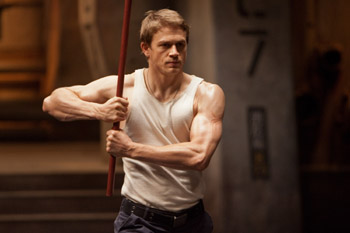 Charlie Hunnam as Raleigh Becket. Photo courtesy of Warner Bros. Pictures. © 2013 WARNER BROS. ENTERTAINMENT INC. AND LEGENDARY PICTURES FUNDING, LLC
Charlie Hunnam as Raleigh Becket. Photo courtesy of Warner Bros. Pictures. © 2013 WARNER BROS. ENTERTAINMENT INC. AND LEGENDARY PICTURES FUNDING, LLCThat theory resulted in most Jaeger co-pilot teams being immediate family, as is the case with Raleigh Becket and his older brother, Yancy, played by Diego Klattenhoff. As soon as the Jaegers started gaining the upper hand against the monstrous invaders, their heroic pilots became nothing less than rock stars to a grateful and adoring public. When we meet Raleigh, he has the swagger of a Jaeger jockey who is on top of the world. Says Charlie Hunnam, “He’s young and full of bravado and lives to kick ass against the Kaiju. He’s doing very well piloting his Jaeger, Gipsy Danger, with his brother, but in their desire to protect humanity, they disobey an order, which turns out to be a tragic mistake that forces Raleigh to leave the Jaeger corps behind.” Del Toro comments, “Raleigh is a man who is basically goodhearted and genuinely earnest and brave. He knows he has a dangerous job, but he has a code of honor that makes him willing to put his life on the line to save another life, despite any risk. Charlie Hunnam was the perfect choice to play Raleigh because he is able to convey that sincerity and purity of heart, and that mix of toughness and vulnerability. I’ve admired his work for years and believe he is on the brink of movie stardom. I was so happy to have the chance to direct him on this film.” Hunnam had met del Toro years earlier and mentions that they also “have Ron Perlman in common,” referring to his “Sons of Anarchy” series castmate and longtime friend of the director. He continues, “I got a call saying that Guillermo was interested in me for this new film. We met and he gave me a vague outline of the story and who the character was. Then, about a week later, he called and offered it to me. Of course I said yes, and that was the first time in my career that I committed to a project without first reading the script. It was a leap of faith because, script or no script, I was signing on to work with Guillermo. He’s in a class of his own in both his imagination and his ability to bring together fantastical but fully dimensional worlds that you can believe in.” The desire to work with del Toro was shared by the entire cast. Idris Elba affirms, “Guillermo is such an interesting filmmaker, and I was intrigued by what he would do with this ambitious script. I definitely wanted to be part of that.” Rinko Kikuchi agrees. “He is a true artist. I knew if he was directing a monster movie, it was going to be more than just a monster movie. It’s going to be something special. Being part of this film is a dream come true.”
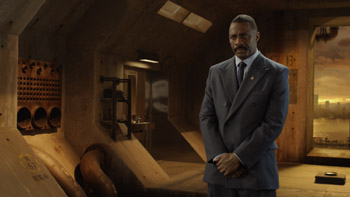 Idris Elba as Stacker Pentecost. Photo courtesy of Warner Bros. Pictures. © 2013 WARNER BROS. ENTERTAINMENT INC. AND LEGENDARY PICTURES FUNDING, LLC
Idris Elba as Stacker Pentecost. Photo courtesy of Warner Bros. Pictures. © 2013 WARNER BROS. ENTERTAINMENT INC. AND LEGENDARY PICTURES FUNDING, LLCElba plays Stacker Pentecost who had been the commander of the Pan Pacific Defense Corp before the Jaeger Program was cut when the world leaders decided to shift their resources to other forms of defense. Now he leads those who are willing to stand with him in the Resistance. The actor calls his character “a lifelong soldier and a natural born leader. No matter how big the problem is, his attitude is, ‘I’m going to find a way to fix this.’ Even after he loses his funding, he is still determined to fight and rally those who are left. Pentecost will not give up, even though he doesn’t have much to work with against an increasing number of Kaiju attacks. But as a strategist and a soldier, his only job is to figure out how to survive and to win.” Tull expounds, “Stacker Pentecost has to be the ultimate warrior—true north in a world full of chaos. When the world appears to be crumbling around him, he is just steely-eyed. Idris was the man; I can’t imagine anyone else in that role, and I think audiences are going to love him.” If Pentecost is going to keep up the fight, he is going to need every remaining Jaeger and Jaeger pilot... even someone who’s been out of the game for five years. Elba says, “Pentecost goes and seeks Raleigh out, believing once a soldier always a soldier. Their relationship is a bit strained at first because Raleigh is a man who marches to the beat of his own drum. But they have a lot of respect for each other, as soldiers and as men.”
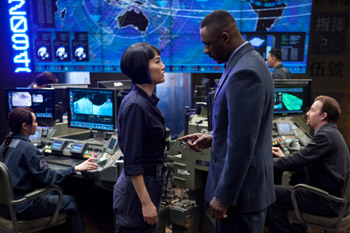 Rinko Kikuchi as Mako Mori and Idris Elba as Stacker Pentecost. Photo courtesy of Warner Bros. Pictures. © 2013 WARNER BROS. ENTERTAINMENT INC. AND LEGENDARY PICTURES FUNDING, LLC
Rinko Kikuchi as Mako Mori and Idris Elba as Stacker Pentecost. Photo courtesy of Warner Bros. Pictures. © 2013 WARNER BROS. ENTERTAINMENT INC. AND LEGENDARY PICTURES FUNDING, LLC“Now,” Hunnam offers, “the challenge is to find somebody Raleigh can be compatible enough with to drive a Jaeger together.” There is one young woman who shows tremendous promise as a Jaeger pilot, although she has been held back by forces without and within. Kikuchi was cast as Mako Mori, whose appearance belies her true strength. Del Toro reveals she had been his choice for the role from the start. “I love Rinko,” he states. “Alejandro González Iñárritu first introduced me to her years ago when they were touring for ‘Babel.’ What really impressed me was how tough and yet delicate she was. That was essential to the character of Mako, a girl who dreams of being a pilot more than anything in the world.” Kikuchi says, “Mako has wanted to be a Jaeger pilot ever since her parents were killed in an attack when she was a child. She is battling monsters and her own demons. She has something to prove to herself and to Pentecost, who is her hero and her mentor. He taught her everything she knows, but he still thinks she is too traumatized to join the fight. He wants to protect her and keep her out of harm’s way.” “Rinko did a phenomenal job,” Tull declares. “You’ve got all these macho guys in the movie, and then there’s Rinko, who is the sweetest, most adorable young lady you’d ever want to meet. But when the cameras rolled, no matter how physically arduous the scene was, she absolutely brought it.”
 Robert Maillet as Lt. S. Kaidanovsky and Heather Doerksen as Lt. A. Kaidanovsky. Photo courtesy of Warner Bros. Pictures. © 2013 WARNER BROS. ENTERTAINMENT INC. AND LEGENDARY PICTURES FUNDING, LLC
Robert Maillet as Lt. S. Kaidanovsky and Heather Doerksen as Lt. A. Kaidanovsky. Photo courtesy of Warner Bros. Pictures. © 2013 WARNER BROS. ENTERTAINMENT INC. AND LEGENDARY PICTURES FUNDING, LLCThe other remaining Jaeger pilots hail from the far corners of the Pacific Rim, and, like their leader, Pentecost, they have no intention of standing down even in the face of seemingly impossible odds. The imposing Kaidanovsky siblings, played by Robert Maillet and Heather Doerksen, handle the Russian Cherno Alpha. China’s Crimson Typhoon is uniquely configured for three pilots, to accommodate the Wei Tang triplets, played by Charles, Lance and Mark Luu. Australia’s Striker Eureka is driven by Herc Hansen and his son, Chuck, played by Max Martini and Rob Kazinsky, respectively. Despite their small number, some of the veterans are reluctant to accept Raleigh into their ranks, especially the Australians. Martini asserts, “He’s not exactly welcomed with open arms. In any sort of military situation, you are reliant on the other people to have your back; you need that trust. And because Raleigh comes in with a questionable history, everyone is a little skeptical of him, wondering if he can earn his stripes.”
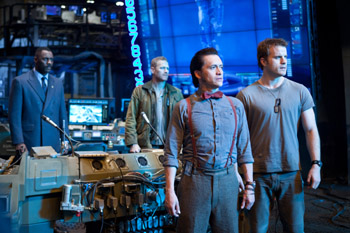 Idris Elba as Stacker Pentecost, Max martini as Herc Hansen, Clifton Collins, Jr. as Ops Tendo Choi and ROB KAZINSKY as Chuck Hansen. Photo courtesy of Warner Bros. Pictures. © 2013 WARNER BROS. ENTERTAINMENT INC. AND LEGENDARY PICTURES FUNDING, LLC
Idris Elba as Stacker Pentecost, Max martini as Herc Hansen, Clifton Collins, Jr. as Ops Tendo Choi and ROB KAZINSKY as Chuck Hansen. Photo courtesy of Warner Bros. Pictures. © 2013 WARNER BROS. ENTERTAINMENT INC. AND LEGENDARY PICTURES FUNDING, LLCNo one is more skeptical than Chuck Hansen, who “has a definite chip on his shoulder,” Kazinsky admits. “He was raised in a world at war and has lived his entire life to only one end: killing Kaiju. That’s all that matters to him, so he’s demanding to the extreme—on himself, his father, and especially this guy who was already a proven failure. I don’t think Chuck means to act like a jerk; he’s behaving that way because he knows his life could depend on Raleigh and doesn’t think he’ll be in safe hands. When he feels someone is going to let the team down when it counts, he doesn’t want them on the team at all.” The soldiers in the Resistance are not limited to the Jaeger jockeys. Clifton Collins, Jr. appears as Tendo Choi, a brilliant engineer who serves as a kind of land-sea-air traffic controller in the Jaeger operations center. In researching for the role, Collins says, “I picked up a copy of Robot Building for Dummies just to get some fundamentals. Obviously, there’s so much fantasy incorporated into our Jaegers, but learning the nature of basic robotics helped me a lot.” Behind the lines, there is another duo who are taking a more scientific approach to fighting the Kaiju by trying to stop the invasion at its source. But it might help if they could first stop fighting with each other. Charlie Day, who was cast as Dr. Newton Geiszler, remarks, “Newton is obsessed with these monsters and believes he is the foremost expert on them.”
 A Kaiju, code name Leatherback. Photo courtesy of Warner Bros. Pictures. © 2013 WARNER BROS. ENTERTAINMENT INC. AND LEGENDARY PICTURES FUNDING, LLC
A Kaiju, code name Leatherback. Photo courtesy of Warner Bros. Pictures. © 2013 WARNER BROS. ENTERTAINMENT INC. AND LEGENDARY PICTURES FUNDING, LLC“But he’s not,” counters Burn Gorman, who plays Herman Gottlieb. “Newt thinks the solution is biological, but Herman believes the answer is in his mathematical calculations. There’s a lot of friction between them because they are both searching for a solution to the same problem, but their methods are entirely at odds and both of them think they are always right all of the time. And the clock is ticking.” “Newt faces some interesting quandaries,” Day says. “One: the potential end of the world. Two: a lab partner who is constantly contradicting him. Three: being the smartest man on the planet and trying not to sound arrogant about it, but, hey, that’s who he is,” the actor kids. “Let’s face it, he’s a nerdy scientist, but he resents the nerdy scientist stereotype, so he rebels against it with his tattoos and leather coat.” Avoiding stereotypes was exactly what del Toro was trying to do with the characters of Geiszler and Gottlieb. He details, “In a movie where you have to explain different environments and the creatures that function within them, there often comes a point where you need a science guy. And, unfortunately, this science guy can sometimes be the most boring part of the movie. So we studiously tried to avoid that by dividing the exposition duties between Charlie Day and Burn Gorman, who guide you through the science of the film in the funniest and most entertaining way.”
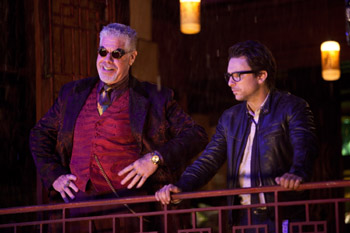 Ron Perlman as Hannibal Chau and Charlie Day as Dr. Newton Geiszler. Photo courtesy of Warner Bros. Pictures. © 2013 WARNER BROS. ENTERTAINMENT INC. AND LEGENDARY PICTURES FUNDING, LLC
Ron Perlman as Hannibal Chau and Charlie Day as Dr. Newton Geiszler. Photo courtesy of Warner Bros. Pictures. © 2013 WARNER BROS. ENTERTAINMENT INC. AND LEGENDARY PICTURES FUNDING, LLCWhile the rest of humanity wants desperately to annihilate the Kaiju, one man has turned the invasion into his own cottage industry. Ron Perlman portrays Hannibal Chau, who has profited handsomely from selling Kaiju parts on the black market and has no intention of helping the Resistance kill his cash cow. “If that came to pass, he’d be selling used cars someplace, and that is not okay with Hannibal,” he laughs. “Hannibal loves his creature comforts,” Perlman continues. “He’s a pure hedonist; he likes to be surrounded by rare, exotic things and has allegiance to no one and nothing except his own insatiable appetites. It was a delicious role to play because he is utterly ruthless and unpredictable.” Del Toro says, “Hannibal is a pirate. I knew Ron would have fun with the role and let the audience have fun with it, too. He created a character I think they will love to hate.” Perlman’s association with del Toro dates back 20 years and includes all of the director’s features. “It’s always fantastic to work with my favorite filmmaker, especially on a movie where he gets to play with all the toys that his incredible imagination will allow him to fashion,” the actor says. “He’s also a collaborative director who appreciates having talented, dedicated people around him. He loves when people are firing on all cylinders.” Hunnam agrees. “Guillermo is a very hands-on director and had a clear idea of what he wanted. But he also welcomed the actors participating in shaping our characters. If we came in with strong ideas, he was open to exploring them.”
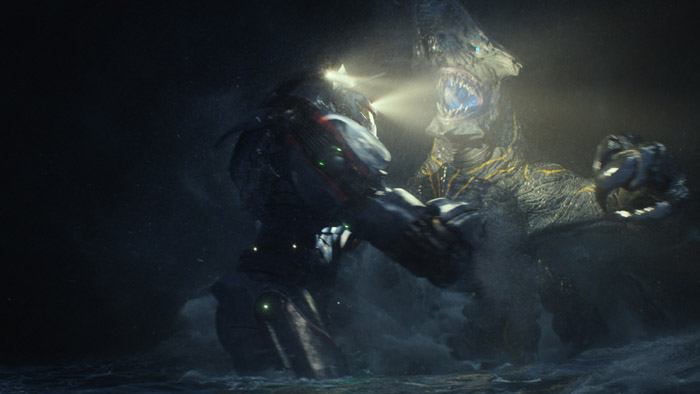 The United States` Gipsy Danger battles a Kaiju, code name Knifehead. Photo courtesy of Warner Bros. Pictures. © 2013 WARNER BROS. ENTERTAINMENT INC. AND LEGENDARY PICTURES FUNDING, LLC
The United States` Gipsy Danger battles a Kaiju, code name Knifehead. Photo courtesy of Warner Bros. Pictures. © 2013 WARNER BROS. ENTERTAINMENT INC. AND LEGENDARY PICTURES FUNDING, LLCJAEGERS VS. KAIJU
“In order to fight monsters, we created monsters of our own.” Del Toro was largely responsible for shaping what are, literally speaking, the biggest stars of “Pacific Rim”: the Kaiju. “I love monsters,” states the director who conceived all the various monsters in the film in conjunction with an elite band of concept artists, illustrators, sculptors, and designers. “We had some of the best creature designers in the world involved in the making of the Kaiju.” Del Toro began with a group that included artist and illustrator Francisco Ruiz Velasco, Wayne Barlowe, Stephen Schirle, Doug Williams, Hugo Martin, Tyruben Ellingson, Guy Davis, Oscar Chichoni, David Meng, Simon Lee, Raul Monge, Carlos Salgado, Keith Thompson, Simon Webber, Allen Williams and Rob McCallum.
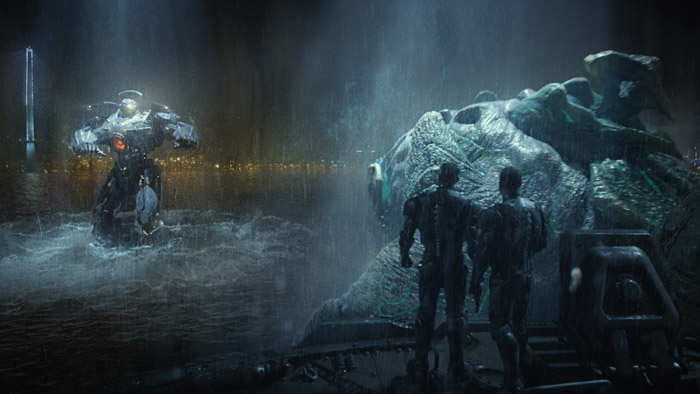 The United States` Gipsy Danger approaches the Kaiju code named Leatherback as Chuck Hansen and Herc Hansen look on. Photo courtesy of Warner Bros. Pictures. © 2013 WARNER BROS. ENTERTAINMENT INC. AND LEGENDARY PICTURES FUNDING, LLC
The United States` Gipsy Danger approaches the Kaiju code named Leatherback as Chuck Hansen and Herc Hansen look on. Photo courtesy of Warner Bros. Pictures. © 2013 WARNER BROS. ENTERTAINMENT INC. AND LEGENDARY PICTURES FUNDING, LLCMembers of the team brainstormed for weeks, beginning in a windowless room they appropriately dubbed “the submarine.” Together, they examined everything: from sizes, shapes and colors to how the immense beings moved and fought. Del Toro says, “We wanted to evoke the sheer awe and terror that one would feel when coming upon one of these monsters.” He set down certain parameters: an example being that any animal kingdom inspirations were primarily limited to lizards, crustaceans and insects. For the most part, however, the think tank could let their imaginations run wild, taking a tag team approach as they pooled ideas. Recalling some of the process, del Toro describes, “Guy Davis would start a design and then Francisco took a stab at it. Then Simon Webber rendered it and Dave Meng would sculpt it. Seeing all those iterations of the creatures enabled us to make them all individual.” The designers gave the Kaiju different nicknames that were indicative of their most prominent physical attributes, like Knifehead, Axehead, Leatherback, etc. Some are viciously calculated, others are more raw power. “They are living weapons,” del Toro says. “They are blind instinct combined with tactical intelligence, capable of making instant decisions in battle, so there are definitely a few surprises.” Making them even more fearsome, every appendage on the Kaiju bodies is part of their arsenal. And, as Thomas Tull points out, “They are quickly evolving. With every attack, they learn something and continually progress in both size and tactics.”
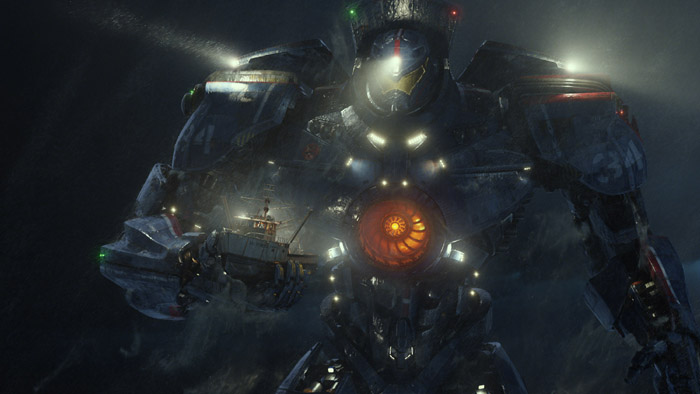 The United States` Gipsy Danger moves a crab fishing boat out of danger. Photo courtesy of Warner Bros. Pictures. © 2013 WARNER BROS. ENTERTAINMENT INC. AND LEGENDARY PICTURES FUNDING, LLC
The United States` Gipsy Danger moves a crab fishing boat out of danger. Photo courtesy of Warner Bros. Pictures. © 2013 WARNER BROS. ENTERTAINMENT INC. AND LEGENDARY PICTURES FUNDING, LLCMany of the same artists who helped bring about the Kaiju also lent their talents to the formation of mankind’s last line of defense: the Jaegers. Beacham says, “The biggest challenge in the world of ‘Pacific Rim’ is finding a way to beat the Kaiju on their own terms. That was the whole idea behind the invention of the Jaegers.” Just as every Kaiju is unique, each Jaeger is distinct in both design and function, with its own array of weapons, “so every time you see a Jaeger go up against a Kaiju, it’s a completely different fight,” says del Toro. The once mighty Jaeger fleet has been reduced to four surviving robots. The director wanted the huge war machines to appear combat-worn, with markings that flaunt the number of enemies downed. Their shape, color and insignias reflect their country of origin, as do their fighting styles. Del Toro equates the look of the U.S. of A.’s Gipsy Danger to “a classic gunslinger heading into a fight. A mixture of a deco skyscraper and John Wayne. Gipsy has swagger and is made to resemble a WWII fighter jet in paint job and details.” A Mark 3, it is considered an old Jaeger and, although it’s been refurbished, it still carries the scars of war…as do its pilots.
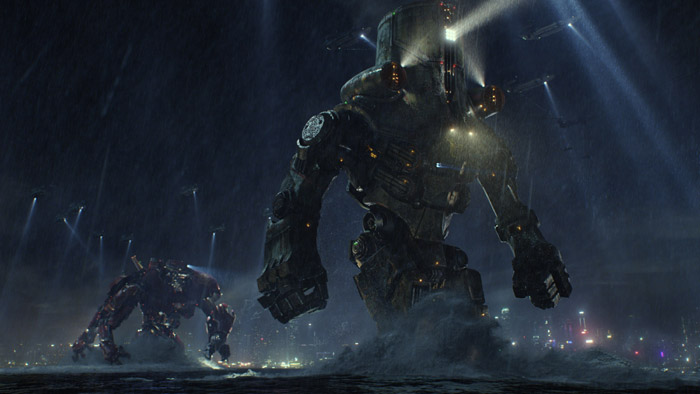 Russia`s Cherno Alpha and China`s Crimson Typhoon. Photo courtesy of Warner Bros. Pictures. © 2013 WARNER BROS. ENTERTAINMENT INC. AND LEGENDARY PICTURES FUNDING, LLC
Russia`s Cherno Alpha and China`s Crimson Typhoon. Photo courtesy of Warner Bros. Pictures. © 2013 WARNER BROS. ENTERTAINMENT INC. AND LEGENDARY PICTURES FUNDING, LLCRussia’s Cherno Alpha is a T-series Jaeger with an oversized nuclear reactor. Its exceptional brawn makes up for its more lumbering gait. It is the oldest, heaviest Jaeger in the surviving fleet. “Brute force and blunt trauma are its calling cards,” says Thomas Tull. China’s Crimson Typhoon is a Mark 4, the only Jaeger with three arms, thanks to its three-man pilot team. Its moves are as close as a massive Jaeger can get to martial arts. Jon Jashni observes, “Some of what they’re able to pull off in the course of the movie is a function of them being able to do more with more.” The Resistance has one Mark 5: Australia’s Striker Eureka. Being the latest model, it boasts faster speed and better maneuverability. “But it’s an Aussie brawler, so it has a lot of bravado and a bit of a strut, like a guy who would pick a fight in a bar,” del Toro teases.
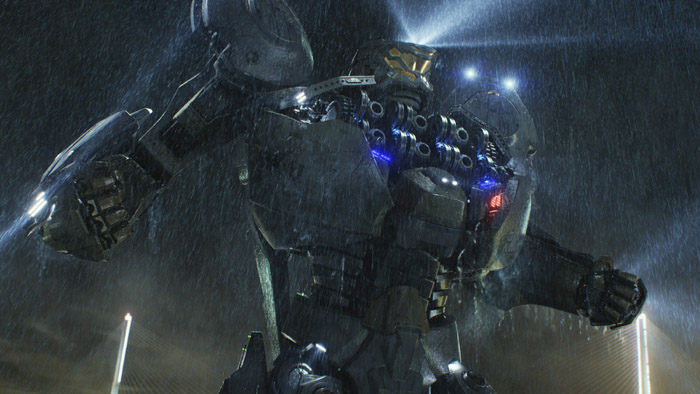 Australia`s Striker Eureka. Photo courtesy of Warner Bros. Pictures. © 2013 WARNER BROS. ENTERTAINMENT INC. AND LEGENDARY PICTURES FUNDING, LLC
Australia`s Striker Eureka. Photo courtesy of Warner Bros. Pictures. © 2013 WARNER BROS. ENTERTAINMENT INC. AND LEGENDARY PICTURES FUNDING, LLCAlthough the Jaegers would exist only on screen, a great deal of planning went into the mechanics of the robots. “From a technical standpoint, we decided to build them from the inside out in diagrams,” reveals del Toro. “We determined the way the pistons, the relays, the torque, the transmission, the engines, and every other element worked in detail. Then we pulled back and started figuring out the vents, the thermal insulation, the outer skin and so on.” With the designs of the Kaiju and Jaegers in place, it was up to the visual effects team at ILM, headed by visual effects supervisor John Knoll, to pit them against each other using state-of-the-art computer animation. Knoll says, “We knew this was going to be a large and very complex project. Every effects sequence had its own challenges, not only in bringing to life these characters but in their interaction with the environments: from the large-scale fluid simulation on the ocean; to the solid surfaces of the cities’ buildings and pavements; and going completely underwater, where we have silt and plankton and hydrothermal vents. Each shot presented an intricate cocktail of elements that had to be blended just so.” James E. Price, who also served as a visual effects supervisor, says, “We were excited about working with ILM because they not only have an incredible character animation team but also the production pipeline needed to accomplish the sophisticated effects for the interaction between the Kaiju and Jaegers, as well as the water and urban environments where the battles take place.”
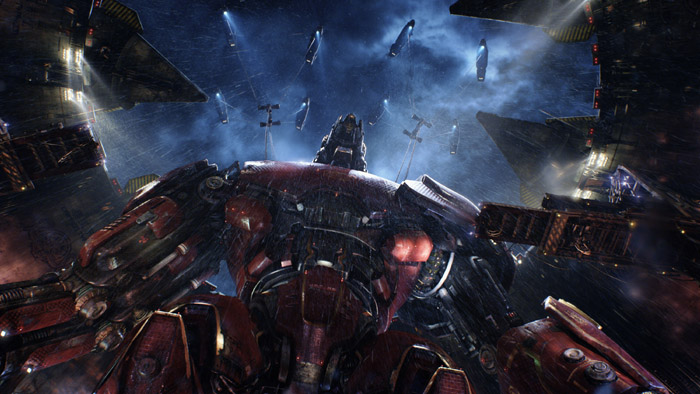 China`s Crimson Typhoon. Photo courtesy of Warner Bros. Pictures. © 2013 WARNER BROS. ENTERTAINMENT INC. AND LEGENDARY PICTURES FUNDING, LLC
China`s Crimson Typhoon. Photo courtesy of Warner Bros. Pictures. © 2013 WARNER BROS. ENTERTAINMENT INC. AND LEGENDARY PICTURES FUNDING, LLCTull remarks, “When you think about the pedigree of ILM, from “Star Wars” on, and then you marry that up with a director like Guillermo del Toro... we felt very fortunate. The first time we went up to ILM and saw some of the finished shots, it was awe inspiring.” “Guillermo is the ideal director to work with on something like this. He had a very clear vision of what he wanted to see, could articulate it well, and was consistent in his pursuit of that vision,” says Knoll, who worked alongside animation supervisor Hal Hickel at ILM. “I had the best experience working with ILM,” del Toro states. “John and Hal are two people I respect and admire so much—real creative partners. I knew I could count on them, as well as Jamie, to help us deliver something amazing.” The sheer size of the combatants posed a major obstacle. Knoll offers, “A big hurdle for us was to try and strike the right balance between speed and scale, because if you think about how big these things are, the physics would dictate that they would need to move slower. But then if they move too slowly, the action is not as exciting, so we had to find a way to make them go fast enough without blowing the scale. And that was made harder by the different environments they were in, whether it’s splashing water or shattering concrete. All of these things had to be simulated in the computer with a believable sense of gravity and scale, so we had to constantly make adjustments to make it all work well together.” Price confirms, “How do you frame up a Kaiju or a Jaeger that’s 250 feet high and get the audience to identify with something that large? We needed to convey the scale, both in water and on land. Having them together in any one arena required very specific effects.” That was largely due to the juxtaposition of the mechanical Jaegers with the organic Kaiju. Putting the Jaegers in motion proved the more complicated process, because Hickel’s team had to impart a suggestion of robotic movement while avoiding anything too herky-jerky.
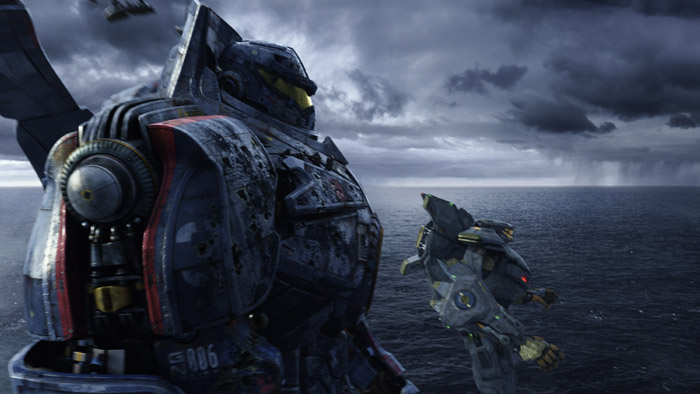 The United States` Gipsy Danger and Australia`s Striker Eureka. Photo courtesy of Warner Bros. Pictures. © 2013 WARNER BROS. ENTERTAINMENT INC. AND LEGENDARY PICTURES FUNDING, LLC
The United States` Gipsy Danger and Australia`s Striker Eureka. Photo courtesy of Warner Bros. Pictures. © 2013 WARNER BROS. ENTERTAINMENT INC. AND LEGENDARY PICTURES FUNDING, LLCIn order to make the warfare look more theatrical, del Toro determined that there should always be something tangible in the atmosphere, whether rain, snow, fog, smoke or embers. The running lights on the Jaegers would then illuminate the particles in the air, generating a radiant dome. Del Toro also used the robots’ own perimeter lights to great effect, clarifying, “Throwing too much light on them would actually seem to miniaturize them.” Instead, by limiting the light source to what was on the Jaegers and brightening the background a bit, they projected a more imposing silhouette. The VFX team often took cues from what was being accomplished on set, never more so than in the Conn-pod—the Jaeger cockpit located in the head of the robot, from which the pilots controlled its every move. Price explains, “We watched what the actors were doing in the Conn-pod and, to a certain extent, could extrapolate that to the movement of the Jaeger. Just as the pilots’ motion informs the Jaegers, the actors’ performances were a springboard for us.”
 Raleigh Becket and Mako Mori in the Conn-pod. Photo courtesy of Warner Bros. Pictures. © 2013 WARNER BROS. ENTERTAINMENT INC. AND LEGENDARY PICTURES FUNDING, LLC
Raleigh Becket and Mako Mori in the Conn-pod. Photo courtesy of Warner Bros. Pictures. © 2013 WARNER BROS. ENTERTAINMENT INC. AND LEGENDARY PICTURES FUNDING, LLCCONN-PODS
“Two pilots. Our minds and our memories connected. The man and machine became one.” Whenever possible, del Toro prefers to accomplish scenes in-camera, and while that was not feasible for waging war between the Kaiju and Jaegers, the sequences inside the Conn-pods were another matter. Constructed on a soundstage at Pinewood Studios in Toronto, the main Conn-pod set was a design and engineering feat, involving the collaboration of numerous people, including production designer Andrew Neskoromny, cinematographer Guillermo Navarro, special effects supervisor Laird McMurray, and Shane Mahan of Legacy Effects.
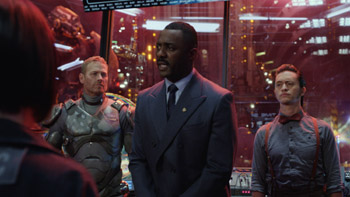 Max Martini as Herc Hansen, Idris Elba as Stacker Pentecost and Clifton Collins, Jr. as Ops Tendo Choi. Photo courtesy of Warner Bros. Pictures. © 2013 WARNER BROS. ENTERTAINMENT INC. AND LEGENDARY PICTURES FUNDING, LLC
Max Martini as Herc Hansen, Idris Elba as Stacker Pentecost and Clifton Collins, Jr. as Ops Tendo Choi. Photo courtesy of Warner Bros. Pictures. © 2013 WARNER BROS. ENTERTAINMENT INC. AND LEGENDARY PICTURES FUNDING, LLCWeighing in at approximately 20 tons, the set stood approximately 20 feet high... though it rarely stood still. It was built on a giant hydraulic gimbal, dubbed “Mighty Mo,” which could raise, drop, roll, and shake the entire set, and everyone on it. The steep angles necessitated that the entire structure be raised almost to the ceiling of the stage before even initiating motion. McMurray relates, “The hardest part was the engineering of all the steel that supports everything, because as you add the people and equipment, not to mention water, we’re talking about 75,000 pounds. When you’re moving that much weight -- and moving it fast -- the mechanics of how it’s going to hold together get a little complicated.” A second Conn-pod sat on a smaller gimbal, nicknamed “Shake ‘n’ Bake,” which involved a system of air bags to allow a rolling motion, although, as its name suggests, it was capable of producing equally unsettling seismic activity. It also kept the set lower to the ground, allowing del Toro to helm scenes at eye level. States del Toro, “I wanted the clashes to be very intense, and all these things provided an interaction that is more immediate and visceral, because the actors are truly reacting to the impact in a physical way. When they threw a punch, the set threw that punch with them; when they are hit by the Kaiju, the force would knock them backwards and really rock them.” Neskoromny customized the Conn-pod sets to correspond to the different Jaegers, so the set had to be repeatedly redressed depending on which duo was at the helm. The designer notes, “Like the exteriors of the Jaegers, we wanted the interiors to have their own identity, so we used color and the appropriate graphics to represent not only the characters, but also their cultures. They were also distressed to show the marks of earlier battles.” Lighting was integral to establishing the color scheme. Navarro had the sets outfitted with LED lights, which could be changed to different hues and patterns to further distinguish each country’s Conn-pod.
 Max Martini as Herc Hansen and Rob Kazinsky as Chuck Hansen. Photo courtesy of Warner Bros. Pictures. © 2013 WARNER BROS. ENTERTAINMENT INC. AND LEGENDARY PICTURES FUNDING, LLC
Max Martini as Herc Hansen and Rob Kazinsky as Chuck Hansen. Photo courtesy of Warner Bros. Pictures. © 2013 WARNER BROS. ENTERTAINMENT INC. AND LEGENDARY PICTURES FUNDING, LLCBy far, the most prominent feature of the Conn-pods was the elaborate apparatus by which the pilots drove the Jaegers, designed and built by Legacy Effects. Del Toro outlines, “This exo-machine connects the Jaeger with the pilots through their suits, so every move of their muscles is transmitted to the corresponding part of the robot. They physically manipulate every step and every strike, so they are able to fight mano-a-mano, pitting this gigantic entity against these monstrous creatures. It’s completely immersive.” The director acknowledges, “The easiest thing to do would have been to use motion capture, giving the actors total freedom of movement. But I felt we needed something that would provide real resistance.” That was an understatement. The entire contraption, weighing several thousand pounds, was attached to the “flight suits” via fittings on the hands, arms and back. Additionally, the actors’ feet were encased in heavy boots that were fastened onto platforms, resembling skis on a stair stepper. Between that and the gimbals, “the actors were in for a ride,” del Toro grins. “It was a little like an amusement park simulator.” “Amusement” might not have been the word the cast would have used to describe the experience. Charlie Hunnam deadpans, “Unless you have a fetish for wearing a suit of armor while working out on an elliptical machine, with 200 gallons of water being poured on you a minute, there was nothing you could do to prepare yourself for filming in the Conn-pod.”
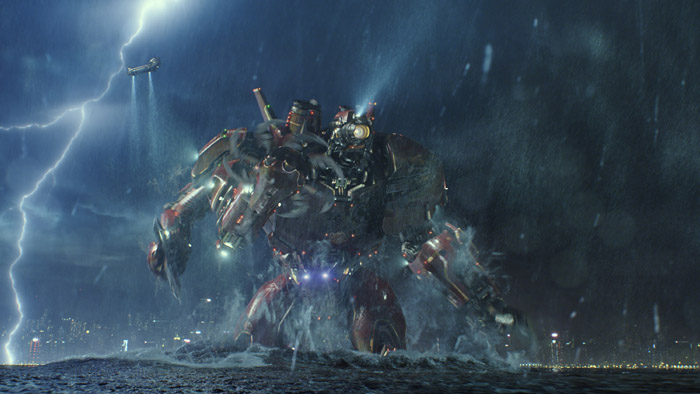 China`s Crimson Typhoon. Photo courtesy of Warner Bros. Pictures. © 2013 WARNER BROS. ENTERTAINMENT INC. AND LEGENDARY PICTURES FUNDING, LLC
China`s Crimson Typhoon. Photo courtesy of Warner Bros. Pictures. © 2013 WARNER BROS. ENTERTAINMENT INC. AND LEGENDARY PICTURES FUNDING, LLCWater was an important element, given the fact that much of the war is being fought in the Pacific Ocean. The VFX team was responsible for rendering large bodies of water for exterior sequences, including the battlegrounds of the Jaegers and Kaiju. However, the special effects department took a more practical approach for interiors. McMurray says, “We had huge water sprayers all over the Conn-pod that were set to release differing amounts of water on cue, sometimes upwards of a thousand gallons a take. And it had to be heated because it was winter. In Canada. On top of that we had extensive LED lighting... which occasionally doesn’t like water.” Even those merely observing recognized the rigors of the Conn-pod. Jon Jashni recalls, “When I saw the Conn-pod set, my first thought was that I wanted to strap in and pretend I was piloting a Jaeger. But once I saw the wet and wild roller coaster that Charlie and the other actors were dealing with, I was glad to be sitting behind the camera.” “It was extremely tough,” Idris Elba avows. “The suits we were wearing were definitely designed for combat, not comfort. But we knew the Conn-pod sequences were important for understanding what the human beings are going through inside the robot’s head, so the effort was well worth it.” Although outwardly the smallest of the Jaeger jockeys, Rinko Kikuchi seemed to handle it all even better than the guys. “We all marveled at her,” says Mary Parent. “She had her own process of getting through the hours in the Conn-pod by going to a kind of Zen place. She ended up being the heartiest of them all.” “I had a love/hate relationship with the suit,” Kikuchi admits. “It was very physically and emotionally demanding. I just had to think about happy things, like chocolate,” she smiles.
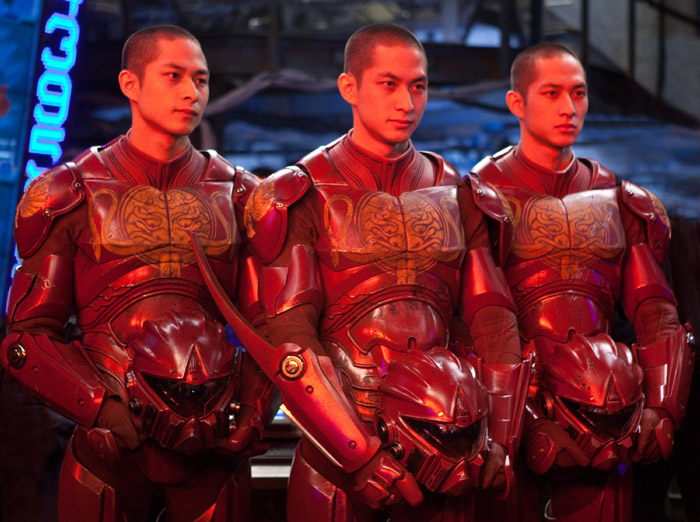 Charles, Lance and Mark Luu as the Wei Tang Triplets. Photo courtesy of Warner Bros. Pictures. © 2013 WARNER BROS. ENTERTAINMENT INC. AND LEGENDARY PICTURES FUNDING, LLC
Charles, Lance and Mark Luu as the Wei Tang Triplets. Photo courtesy of Warner Bros. Pictures. © 2013 WARNER BROS. ENTERTAINMENT INC. AND LEGENDARY PICTURES FUNDING, LLCSUITING UP
“The Jaeger program was born.” Costume designer Kate Hawley collaborated with Shane Mahan and the team at Legacy on the look of the pilots’ specialized suits. “I had the privilege of being part of the concept,” Hawley says. “It was a lovely opportunity to find ways to echo the characters’ personalities, as well as their backgrounds.”
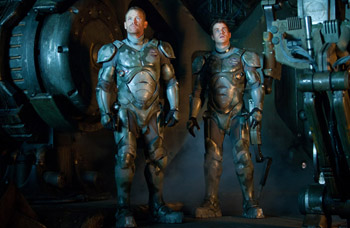 MaxMartini as Herc Hansen and Rob Kazinsky as Chuck Hansen. Photo courtesy of Warner Bros. Pictures. © 2013 WARNER BROS. ENTERTAINMENT INC. AND LEGENDARY PICTURES FUNDING, LLC
MaxMartini as Herc Hansen and Rob Kazinsky as Chuck Hansen. Photo courtesy of Warner Bros. Pictures. © 2013 WARNER BROS. ENTERTAINMENT INC. AND LEGENDARY PICTURES FUNDING, LLC“We worked with Kate in terms of color coordination, and together we came up with some really interesting flourishes,” Mahan adds. Legacy was responsible for the construction of the suits, beginning with digital scans of the actors’ bodies. Mahan comments, “The method has really evolved from the days of plaster casts. Digital scanning allows us to get perfect lines that are more seamless. You still have the process of molding and manufacturing the individual parts, but that initial stage is a much better technique.” Mahan shares that the outer portions of the suit were modular pieces fabricated with lightweight plastics and urethanes, noting, “It’s supposed to be an armored uniform, so it had to look heavy, but it couldn’t be heavy. It was the conundrum of either making it really light, but then it falls apart, or making it sturdy enough to withstand the wear and tear. It ended up being about 25 pounds, which is a fraction heavier than the actors would have preferred, but it wasn’t too bad.” The under suits were made from a printed four-way stretch fabric that was custom fitted to the actors’ bodies. Then the appliqués of armor were placed on, including chest plates, arm and leg pieces, and metal-looking joints. Mahan details. “We were careful to hide all the connections, so when it’s all put together, it looks like one cohesive piece.” The suits could not be cleaned in a traditional way. Instead, they were treated with an anti-bacterial spray and dried overnight using air blowers because, as Mahan states, “There’s nothing worse than getting into a wet Conn-pod pilot suit at 5:00 in the morning.”
 Rinko Kikuchi as Mako Mori. Photo courtesy of Warner Bros. Pictures. © 2013 WARNER BROS. ENTERTAINMENT INC. AND LEGENDARY PICTURES FUNDING, LLC
Rinko Kikuchi as Mako Mori. Photo courtesy of Warner Bros. Pictures. © 2013 WARNER BROS. ENTERTAINMENT INC. AND LEGENDARY PICTURES FUNDING, LLCApart from their Conn-pod gear, the characters had their own personal styles. For Mako Mori’s costumes, Hawley offers, “She’s grown up in a male-dominated environment, so I went with that idea. It made sense to put her in coveralls and dress her like one of the boys.”
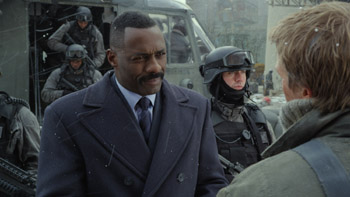 Idris Elba as Stacker Pentecost. Photo courtesy of Warner Bros. Pictures. © 2013 WARNER BROS. ENTERTAINMENT INC. AND LEGENDARY PICTURES FUNDING, LLC
Idris Elba as Stacker Pentecost. Photo courtesy of Warner Bros. Pictures. © 2013 WARNER BROS. ENTERTAINMENT INC. AND LEGENDARY PICTURES FUNDING, LLCStacker Pentecost, on the other hand, is decidedly not just one of the boys. “Guillermo had a clear idea of how he wanted Pentecost to look,” says Hawley. “He chose to leave the military, but he is now the leader of the Resistance, so he still embodies all the qualities of a commander though he’s no longer in uniform. No matter how his world is falling apart, he retains that structure. Guillermo wanted him in a suit and tie, perfectly tailored, without even a wrinkle. You put Idris Elba in a suit and you can’t go wrong. He looks quite splendid.” Hawley had the freedom to get the most outlandish with the costume for Hannibal Chau, going from the ground up. “We started with those shoes,” she says. “They started off being silver, but Guillermo wanted them to be more opulent, so they ended up gold.” Hannibal’s costumes are as garish as his character, in stark contrast to the muted tones of a world at war. The makeup department, headed by Jordan Samuels, completed his visage with gold teeth, a nasty looking scar and a mutilated eye. Hawley had to go to the opposite extreme within the confines of Shatterdome, once the headquarters of the Pan Pacific Defense Corp, now the base of the Resistance. She expounds, “In Shatterdome, the palette is predominantly gray with rust seeping through the walls, and Guillermo wanted that patina to be reflected in the wardrobe of the people who live and work there. We worked very closely with Andrew and his production design team to make the clothes feel like they are literally part of the environment. Throughout production, we took a painterly approach to ensure that each setting informed the costumes.”
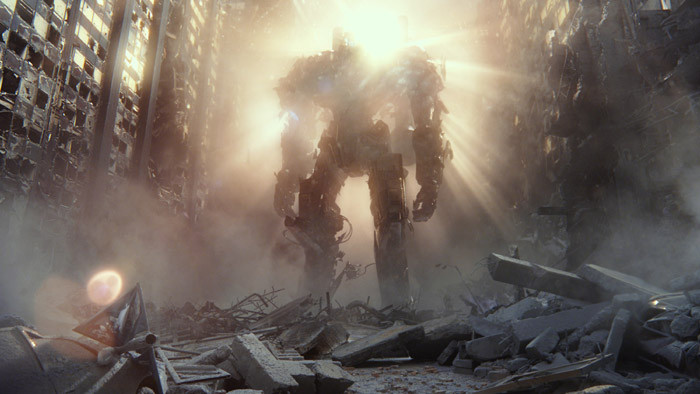 Japan`s Coyote Tango. Photo courtesy of Warner Bros. Pictures. © 2013 WARNER BROS. ENTERTAINMENT INC. AND LEGENDARY PICTURES FUNDING, LLC
Japan`s Coyote Tango. Photo courtesy of Warner Bros. Pictures. © 2013 WARNER BROS. ENTERTAINMENT INC. AND LEGENDARY PICTURES FUNDING, LLCSIGHTS AND SOUNDS
“Today, we face the monsters that are at our door. Today, we are canceling the apocalypse!” Pinewood Studios Toronto served as the base of operations for the “Pacific Rim” production. Executive producer Callum Greene says, “We took over virtually every space at the studio, including all the soundstages, which still weren’t enough. We ended up splitting Stage 8 into two separate stages. It was quite an endeavor.” Neskoromny notes, “The scope of the film required a lot of different looks, from Hong Kong to Tokyo to the various interiors, like Shatterdome and Hannibal Chau’s lair. We were building almost everything on stages, so from a design standpoint, it all had to be manufactured from scratch. We put on the layers of about 15 years going into the future... a future that does not appear hopeful.”
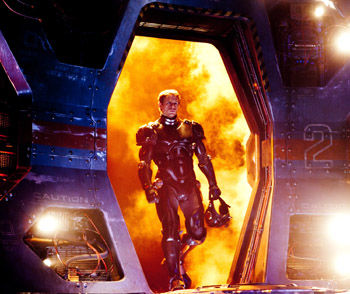 Charlie Hunnam as Raleigh Becket. Photo courtesy of Warner Bros. Pictures. © 2013 WARNER BROS. ENTERTAINMENT INC. AND LEGENDARY PICTURES FUNDING, LLC
Charlie Hunnam as Raleigh Becket. Photo courtesy of Warner Bros. Pictures. © 2013 WARNER BROS. ENTERTAINMENT INC. AND LEGENDARY PICTURES FUNDING, LLCDel Toro observes, “In the time the film takes place, we tried to show a little of how society would be altered and geography would change. There’s a whole domino effect caused by these creatures showing up on our shores. We didn’t want it to look too futuristic because I think what would happen is the reverse. All our technology would go to creating weapons to fight them, and other advancements would slow down.” Shatterdome, the Resistance’s fortress on the water, was fabricated to exhibit the deterioration caused by years of war. Neskoromny says, “The whole concept behind Shatterdome is that they’re nearing the end, so there is a sense of desperation as they struggle to keep everything working. There are no bright colors; everything is faded or yellowing, and you can see the rust and decay.” One of the largest soundstages housed the Loccent, the command center, where Pentecost and Tendo Choi track the Jaegers and Kaiju battles on holographic monitors. A large digital clock on the wall is a constant reminder of the time elapsed since the last Kaiju attack -- increments that are getting increasingly shorter. The most colorful set, by far, was Hannibal Chau’s Hong Kong den, which is secreted behind the walls of an otherwise nondescript apothecary shop. Neskoromny describes, “You come to this store, which is small and very gritty. But then the guy behind the counter pushes a button, and the shelves open up to reveal this jewelry box of a hideaway. It transports you to a completely different place.” The circular-shaped set featured marble floors and columns. Jars lined the shelves, containing random Kaiju parts to be sold on the black market. The design team had to build the streets of Hong Kong in two phases: pre-Kaiju attack, and then the aftermath. An island, constantly in the creatures’ line of fire, the Hong Kong of “Pacific Rim” is a war zone, where invasion alerts send people running to underground shelters, fortified with steel girders. The immense ribcage of a fallen Kaiju towers over the marketplace, and there is a hint of blue tainting everything, resulting from the spilled blood of the aliens.
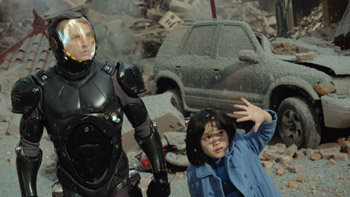 Charlie Hunnam as Raleigh Becket and Mana Ashida as Young Mako. Photo courtesy of Warner Bros. Pictures. © 2013 WARNER BROS. ENTERTAINMENT INC. AND LEGENDARY PICTURES FUNDING, LLC
Charlie Hunnam as Raleigh Becket and Mana Ashida as Young Mako. Photo courtesy of Warner Bros. Pictures. © 2013 WARNER BROS. ENTERTAINMENT INC. AND LEGENDARY PICTURES FUNDING, LLCFollowing a devastating Kaiju attack, “it was all about deconstruction,” says supervising art director Elinor Rose Galbraith. “The streets were all made with real concrete, so we brought in a big excavator that we called a chomper, which basically ate the set. Some of the added rubble had to be lighter materials, like Styrofoam, for safety and weight considerations, but most of it, including all the crushed and burnt out cars, was real.” Neskoromny also designed the ruins of a Tokyo street and alleyway, where, in flashback, we see the young Mako, played by Japanese child star Mana Ashida, running for her life. The alley was built on the soundstage, but the larger street was one of the few outside locations: a Toronto street that was redressed with Japanese signage. Another location was Lake Ontario, which became the Alaska beach where Raleigh, in his crippled Gipsy Danger, comes ashore near the start of the film. Part of Toronto’s historic Hearn Power Plant was turned into the construction site for the ill-conceived anti-Kaiju Wall, where Pentecost tracks down Raleigh to recruit him for the Resistance. “Pacific Rim” was shot using the RED EPIC camera, marking the first time del Toro has used a digital camera for one of his films. One of the main tasks for cinematographer Guillermo Navarro and his department was protecting the cameras from the sometimes torrential artificial rain being generated by the special effects group, as well as the resulting steam from the water under the hot lights. Giant green screens surrounded most of the sets, so the backgrounds could be extended via visual effects, as needed. Jamie Price also traveled to Sydney, Australia, and Hong Kong to gather elements that ILM used to create the digitally rendered skylines for those cities. The VFX team also produced digital re-creations of San Francisco, California, where the Kaiju begin their reign of terror.
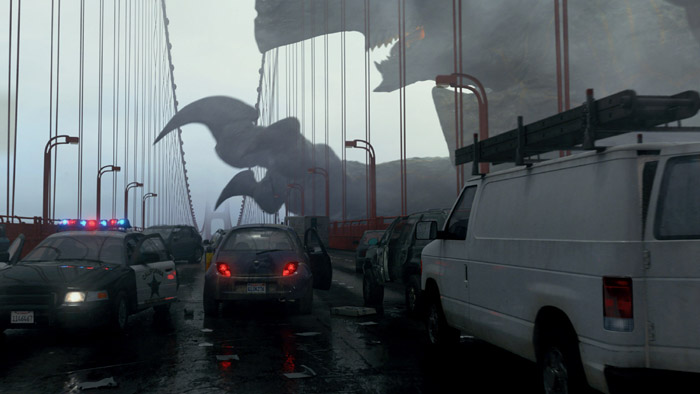 A Kaiju, code name Trespasser, attacks the Golden Gate Bridge. Photo courtesy of Warner Bros. Pictures. © 2013 WARNER BROS. ENTERTAINMENT INC. AND LEGENDARY PICTURES FUNDING, LLC
A Kaiju, code name Trespasser, attacks the Golden Gate Bridge. Photo courtesy of Warner Bros. Pictures. © 2013 WARNER BROS. ENTERTAINMENT INC. AND LEGENDARY PICTURES FUNDING, LLC“We wanted to show that this was a global occurrence,” del Toro states. “The adventure takes you to completely different arenas -- from densely populated cities to the bottom of the sea to the edge of the Earth’s atmosphere. And it’s also a movie that, every time you think you have it figured out, it changes. When you think you know how the battle is going, the battle shifts. When you think you know the stakes, the stakes are raised. So, like the Kaiju, the action continues to evolve.” The scope of the action in “Pacific Rim” was an inspiration to composer Ramin Djawadi, whose music blends orchestra and ethnic flavors to accompany the story and characters. “Big robots and big monsters naturally called for a big orchestra,” he laughs. “Guillermo also liked the idea of electric guitars to implement a rock ‘n’ roll element in the score. Traditional orchestra infused with modern electronics—old meets new.” The multinational nature of the story is also reflected in the music, with the sounds of Japanese Taiko drums, a Chinese Erhu violin, a Russian Choir, and twangy guitars. “One thing Guillermo always said was that the film is about different countries coming together for a common cause, which meant combining different musical styles,” Djawadi relates. “We had fun creating the score.” Reflecting on the shared mission of the story’s heroes, Del Toro affirms, “The movie is very much about sticking together. Not because we’re great, not because we are invincible, but because, ultimately, we need one another and embrace everyone’s uniqueness. And we protect one another; we have each other’s back. So it’s coming from a point of view of solidarity and strength and a belief in humanity.” He concludes, “I want this film to be an inspirational adventure, like the movies I used to watch as a kid. It is my hope that after you see ‘Pacific Rim,’ you’ll want to be a Jaeger jockey. No matter what age you are, you’ll want to jump on board a Jaeger and head right into a Kaiju brawl.”
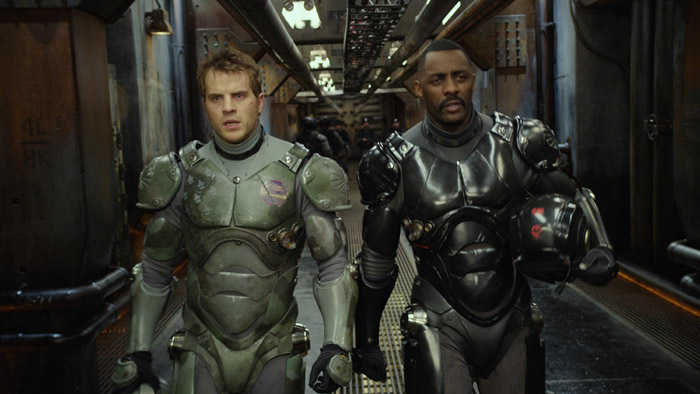 Rob Kazinsky as Chuck Hansen and Idris Elba as Stacker Pentecost. Photo courtesy of Warner Bros. Pictures. © 2013 WARNER BROS. ENTERTAINMENT INC. AND LEGENDARY PICTURES FUNDING, LLC
Rob Kazinsky as Chuck Hansen and Idris Elba as Stacker Pentecost. Photo courtesy of Warner Bros. Pictures. © 2013 WARNER BROS. ENTERTAINMENT INC. AND LEGENDARY PICTURES FUNDING, LLCABOUT THE CAST
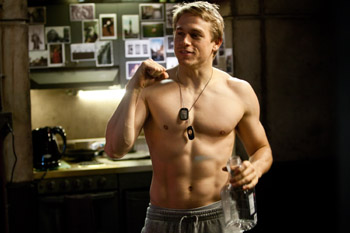 Charlie Hunnam as Raleigh Becket. Photo courtesy of Warner Bros. Pictures. © 2013 WARNER BROS. ENTERTAINMENT INC. AND LEGENDARY PICTURES FUNDING, LLC
Charlie Hunnam as Raleigh Becket. Photo courtesy of Warner Bros. Pictures. © 2013 WARNER BROS. ENTERTAINMENT INC. AND LEGENDARY PICTURES FUNDING, LLCCHARLIE HUNNAM (Raleigh Becket) has gained critical and audience acclaim for his work in films and on television. He is perhaps best known for his starring role as Jackson “Jax” Teller in FX’s “Sons of Anarchy,” the highest-rated drama in the network’s history, which is now in production on its sixth season. On the big screen, Hunnam most recently starred in the independent features “3, 2, 1…Frankie go Boom,” directed by Jordan Roberts, and Matthew Chapman’s “The Ledge” alongside Liv Tyler, Patrick Wilson, and Terrence Howard. Born in England, Hunnam first came to the attention of British television viewers with his starring role on the hit drama series “Queer as Folk.” He became familiar to American audiences as a regular on the FOX comedy series “Undeclared,” created by Judd Apatow. In 2002, Hunnam made his feature film debut in the thriller “Abandon” and then starred in the title role of Douglas McGrath’s screen adaptation of Charles Dickens’ “Nicholas Nickleby,” for which he shared in a National Board of Review Award for Best Acting Ensemble. Hunnam went on to appear in Anthony Minghella’s Civil War-era drama “Cold Mountain,” with Nicole Kidman and Jude Law; the indie film “Green Street Hooligans,” with Elijah Wood; and Alfonso Cuarón’s apocalyptic drama “Children of Men.” Hunnam recently completed his first screenplay entitled “Vlad,” which will be produced by Brad Pitt’s Plan B. IDRIS ELBA (Stacker Pentecost) is a Golden Globe-winning actor who has been recognized for his performances in a wide range of film and television roles, both in the U.S. and in his native England.
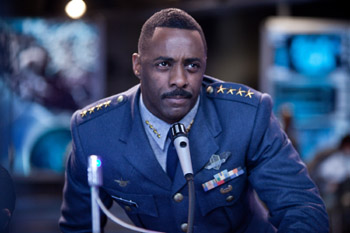 Idris Elba as Stacker Pentecost. Photo courtesy of Warner Bros. Pictures. © 2013 WARNER BROS. ENTERTAINMENT INC. AND LEGENDARY PICTURES FUNDING, LLC
Idris Elba as Stacker Pentecost. Photo courtesy of Warner Bros. Pictures. © 2013 WARNER BROS. ENTERTAINMENT INC. AND LEGENDARY PICTURES FUNDING, LLCHe recently starred in Ridley Scott’s sci-fi thriller “Prometheus,” with Charlize Theron; “Ghost Rider: Spirit of Vengeance,” with Nicolas Cage; and as Heimdall in the superhero action hit “Thor,” directed by Kenneth Branagh. This fall, Elba will be seen starring in two very different films, beginning with the sequel “Thor: The Dark World,” in which he reprises the role of Heimdall. He also stars in Justin Chadwick’s “Mandela: Long Walk to Freedom,” in which Elba portrays the heroic anti-apartheid freedom fighter who became South Africa’s first black president. His other upcoming films include the thriller “No Good Deed,” on which he also serves as executive producer. On television, Elba currently stars in the Golden Globe-nominated BBC series “Luther,” playing the title role of Detective Chief Inspector John Luther. For his work on the show, he has won a Golden Globe, a BET Award and an NAACP Image Award, and earned two Emmy Award nominations, an additional Golden Globe nomination and another Image Award nod. The third installment of the BBC miniseries will air in September 2013. Elba previously shared in a Screen Actors Guild Award® nomination as a member of the cast of Ridley Scott’s 2007 true-life feature “American Gangster,” with Denzel Washington and Russell Crowe. He also received an Image Award nomination for his performance in the 2009 thriller “Obsessed,” opposite Beyoncé Knowles. His additional film credits include “Takers,” with Matt Dillon; “The Losers,” with Jeffrey Dean Morgan, Zoe Saldana and Chris Evans; “Legacy,” which he also executive produced; “The Unborn”; Guy Ritchie’s “RocknRolla,” joining an ensemble cast that also included Gerard Butler, Tom Hardy and Thandie Newton; “28 Weeks Later”; “The Reaping,” with Hilary Swank; and Tyler Perry’s drama “Daddy’s Little Girls.” Elba was already a familiar face to television audiences when he landed his breakthrough role on HBO’s critically acclaimed series “The Wire.” He received an Image Award nomination for his performance as Stringer Bell, the lieutenant of a Baltimore drug cartel on the cult hit show. In 2009, he demonstrated his comic chops when he joined the cast of NBC’s hit series “The Office.” He later appeared as Laura Linney’s character’s love interest in Showtime’s “The Big C,” earning an Emmy nomination for Outstanding Guest Actor in a Comedy Series. Elba also starred in the HBO movie “Sometimes in April.” This year, Elba made his directorial debut with SKYTV’s “Pavement Psychologist” and the music video for Mumford & Sons’ “Lover of the Light.”
 Rinko Kikuchi as Mako Mori. Photo courtesy of Warner Bros. Pictures. © 2013 WARNER BROS. ENTERTAINMENT INC. AND LEGENDARY PICTURES FUNDING, LLC
Rinko Kikuchi as Mako Mori. Photo courtesy of Warner Bros. Pictures. © 2013 WARNER BROS. ENTERTAINMENT INC. AND LEGENDARY PICTURES FUNDING, LLCRINKO KIKUCHI (Mako Mori) was already a star in Japan when she was catapulted onto the international scene with her Oscar-nominated performance in Alejandro González Iñárritu’s 2006 drama “Babel.” For her multi-layered performance as a deaf-mute teenager in that film, she was also honored with Golden Globe, Screen Actors Guild Award®, and Critics’ Choice Award nominations for Best Supporting Actress, and won a National Board of Review Award for Breakthrough Performance. She was also among the film’s ensemble nominated for both Critics’ Choice and SAG Awards® for Outstanding Performance by a Motion Picture Cast. Kikuchi followed her success in “Babel” with prominent roles in such films as “The Brothers Bloom”; “Map of the Sounds of Tokyo”; and “Norwegian Wood,” based on Haruki Murakami’s best-selling novel. Upcoming, she stars opposite Keanu Reeves in “47 Ronin,” a Hollywood take on an old samurai legend, slated for release in December 2013. Kikuchi made her feature film debut in 1999 in the Japanese film “Ikitai” (To Live). Her additional film credits include starring roles in such Japanese films as “Hole in the Sky” and “The Taste of Tea.” Simultaneously pursuing a career in fashion, Kikuchi has modeled for Chanel, Yves Saint Laurent and Tom Ford. She has also been featured in numerous magazines, including Vogue, T Magazine, and Harper’s Bazaar.
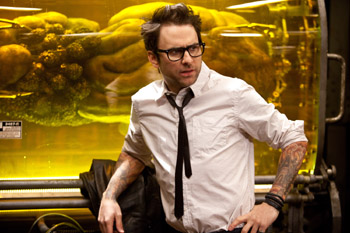 Charlie Day as Dr. Newton Geiszler. Photo courtesy of Warner Bros. Pictures. © 2013 WARNER BROS. ENTERTAINMENT INC. AND LEGENDARY PICTURES FUNDING, LLC
Charlie Day as Dr. Newton Geiszler. Photo courtesy of Warner Bros. Pictures. © 2013 WARNER BROS. ENTERTAINMENT INC. AND LEGENDARY PICTURES FUNDING, LLCCHARLIE DAY (Dr. Newton Geiszler) is an actor, writer and producer whose comedic talents have made him a favorite of audiences and critics alike. Day made his major feature film debut in the 2010 comedy “Going the Distance,” alongside Drew Barrymore, Justin Long and Jason Sudeikis. The following year, he starred in the hit comedy “Horrible Bosses” with Jennifer Aniston, Jason Bateman, Jason Sudeikis, Kevin Spacey and Jamie Foxx, under the direction of Seth Gordon. Day can be heard this summer in the animated feature “Monsters University.” On television, Day is currently starring in his ninth season on the FX comedy series “It’s Always Sunny in Philadelphia.” In 2011, Day’s performance as the hapless Charlie Kelly brought him a nomination for Best Supporting Actor at the inaugural Broadcast Television Journalist Critics’ Choice Awards. He also serves as a writer and executive producer on the show, which he created in collaboration with his friends Rob McElhenney and Glenn Howerton. Previously, Day had a recurring role on NBC’s “Third Watch” and a regular role on the FOX comedy “Luis.” He has also guest starred on several series, including “Reno 911!” and “Law & Order.” Behind the camera, he has served as a consulting producer on the CBS series “How to Be a Gentleman” and an executive producer on the FX series “Unsupervised.” Day began his acting career on the stage, including four years at the Williamstown Theatre Festival. He went on to play the lead role in “Dead End” at the Huntington Theatre in Boston.
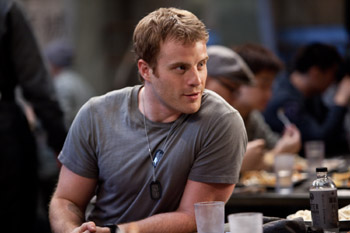 Rob Kazinsky as Chuck Hansen. Photo courtesy of Warner Bros. Pictures. © 2013 WARNER BROS. ENTERTAINMENT INC. AND LEGENDARY PICTURES FUNDING, LLC
Rob Kazinsky as Chuck Hansen. Photo courtesy of Warner Bros. Pictures. © 2013 WARNER BROS. ENTERTAINMENT INC. AND LEGENDARY PICTURES FUNDING, LLCROB KAZINSKY (Chuck Hansen) recently made his feature film debut in the World War II drama “Red Tails,” about the Tuskegee Airmen. On television, he has just joined the cast of the hugely popular HBO series “True Blood,” playing Ben, the new love interest of Anna Paquin’s character, Sookie. Raised in Brighton, England, Kazinsky trained at the Guildford School of Acting from 2002 to 2005, graduating with full honors. He made his professional acting debut in the classic children’s show “The Basil Brush Show,” playing a maniacal music producer named Sven Garley. Shortly after, he was cast as the enigmatic footballer Casper Rose in Sky One’s soccer drama “Dream Team.” Kazinsky was best known to British television audiences for his work on the popular BBC soap opera “EastEnders,” playing the dangerous ex-military man Sean Slater. Cast on the show in 2006, Kazinsky became an instant fan favorite. During his 254-episode run, ending in 2009, he was nominated for a number of awards, including eight British Soap Awards, winning for Best Actor in 2009. He more recently had guest spots on “Law & Order: L.A.” and “Brothers & Sisters.”
 Max Martini as Herc Hansen. Photo courtesy of Warner Bros. Pictures. © 2013 WARNER BROS. ENTERTAINMENT INC. AND LEGENDARY PICTURES FUNDING, LLC
Max Martini as Herc Hansen. Photo courtesy of Warner Bros. Pictures. © 2013 WARNER BROS. ENTERTAINMENT INC. AND LEGENDARY PICTURES FUNDING, LLCMAX MARTINI (Herc Hansen) stars this fall in the true-life drama “Captain Phillips,” about the U.S. Navy SEAL rescue of a cargo ship captain from Somali pirates in 2009. Martini plays the SEAL Commander in the film, directed by Paul Greengrass and starring Tom Hanks in the title role. Next year, Martini stars in David Ayer’s action thriller “Sabotage,” with Arnold Schwarzenegger, Sam Worthington and Terrence Howard. He earlier appeared in Steven Spielberg’s acclaimed World War II drama “Saving Private Ryan,” with Tom Hanks and Matt Damon, and Robert Zemeckis’ “Contact,” with Jodie Foster. Martini’s film credits also include such independent features as “Redbelt,” written and directed by David Mamet; John Dahl’s “The Great Raid”; “Backroads”; and “Cement.” Martini, who has also worked extensively on the small screen, is currently starring in the new NBC series “Crisis.” He recently had a recurring role on the first season of ABC’s hit drama series “Revenge,” and previously starred on the CBS drama series “The Unit,” created by David Mamet. Martini’s long list of television credits also includes Spielberg’s Emmy-winning miniseries “Taken,” and regular roles on “Da Vinci’s Inquest” and “Level 9.” He has also had recurring and guest roles on numerous series, including “Criminal Minds,” “Castle,” “CSI,” Hawaii Five-0,” “Burn Notice,” “CSI: Miami,” and “24.” In addition to his screen work, Martini is active in the theatre and co-founded the Theatre North Collaborative in New York City. A theatre company of American and Canadian actors, it is dedicated solely to producing new works from both sides of the border. He also holds a BFA in painting and sculpture from the School of Visual Arts in Manhattan.
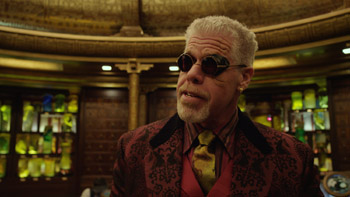 Ron Perlman as Hannibal Chau. Photo courtesy of Warner Bros. Pictures. © 2013 WARNER BROS. ENTERTAINMENT INC. AND LEGENDARY PICTURES FUNDING, LLC
Ron Perlman as Hannibal Chau. Photo courtesy of Warner Bros. Pictures. © 2013 WARNER BROS. ENTERTAINMENT INC. AND LEGENDARY PICTURES FUNDING, LLCRON PERLMAN (Hannibal Chau) is an award-winning and prolific film and television actor who is a favorite of genre fans, due in part to his long association with Guillermo del Toro. They first worked together on the director’s first feature, the 1993 sci-fi thriller “Cronos.” Nine years later, they reunited on the actioner “Blade II.” In 2004, Perlman starred in the title role in del Toro’s “Hellboy,” based on the popular comic book. He reprised his part in “Hellboy II: The Golden Army,” also directed by del Toro. His more recent credits include Dominic Sena’s “Season of the Witch,” with Nicolas Cage; the award-winning action film “Drive,” in which he co-starred with Ryan Gosling, Carey Mulligan and Bryan Cranston under the direction of Nicolas Winding Refn; and Marcus Nispel’s “Conan the Barbarian,” as the father of the title character. On television, Perlman currently stars with Charlie Hunnam in the series “Sons of Anarchy,” which is the highest-rated series in the history of the FX Network. Earlier in his career, he gained a cult following with his portrayal of Vincent in the series “Beauty and the Beast.” For his work on the show, Perlman won a Golden Globe and earned two Emmy nominations for Best Actor in a Drama Series. Perlman’s film career began in 1981 with a lead role in French director Jean-Jacques Annaud’s “Quest for Fire,” for which Perlman received a nomination for Canada’s Genie Award. He has also worked with Annaud in the critically acclaimed “The Name of the Rose,” with Sean Connery, and the World War II drama “Enemy at the Gates,” with Jude Law. Encompassing more than 80 films, his additional credits include “Sleepwalkers”; Stephen Sommers’ “The Adventures of Huck Finn”; Peter Medak’s “Romeo is Bleeding”; Marc Caro and Jean-Pierre Jeunet’s “The City of Lost Children,” which was nominated for the Palme d’Or at the 1995 Cannes Film Festival; John Frankenheimer’s “The Island of Dr. Moreau”; Jeunet’s “Alien: Resurrection,” with Sigourney Weaver; “Happy, Texas”; “Star Trek: Nemesis”; and “The Last Winter.” Perlman earned a Master of Fine Arts degree from the University of Minnesota before beginning his professional stage career in his native New York. He made his Broadway debut in 1979 in the play “Teibele and Her Demon.” He later returned to Broadway in Aaron Sorkin’s “A Few Good Men” and the 1996 revival of William Inge’s “Bus Stop.”
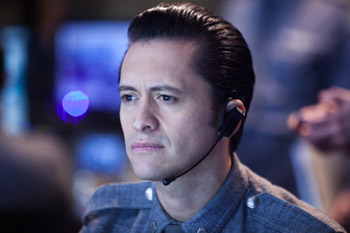 Clifton Collins, Jr. as Ops Tendo Choi. Photo courtesy of Warner Bros. Pictures. © 2013 WARNER BROS. ENTERTAINMENT INC. AND LEGENDARY PICTURES FUNDING, LLC
Clifton Collins, Jr. as Ops Tendo Choi. Photo courtesy of Warner Bros. Pictures. © 2013 WARNER BROS. ENTERTAINMENT INC. AND LEGENDARY PICTURES FUNDING, LLCCLIFTON COLLINS, JR. (Ops Tendo Choi) earned acclaim for his portrayal of murderer Perry Smith in Bennett Miller’s Oscar-nominated biopic “Capote,” also sharing in a Screen Actors Guild (SAG) Award nomination for Outstanding Motion Picture cast. Collins earlier won a SAG Award in the same category for his role in Steven Soderbergh’s “Traffic.” Collins is currently shooting Wally Pfister’s directorial debut feature, “Transcendence,” alongside Johnny Depp, Paul Bettany and Morgan Freeman. His upcoming films also include two Terrence Malick-directed features. Among Collins’ additional credits are Jim Sheridan’s “Brothers”; Mike Judge’s “Extract”; “Crank: High Voltage”; J.J. Abrams’ blockbuster “Star Trek,” as the Romulan Ayel; “Sunshine Cleaning”; Alejandro González Iñárritu’s “Babel”; Michael Avery’s “The Rules of Attraction”; “The Last Castle,” with Robert Redford; Joel Schumacher’s “Tigerland”; Antoine Fuqua’s “The Replacement Killers”; John Singleton’s “Poetic Justice”; and the Hughes Brothers’ films “Dead Presidents” and “Menace II Society.” On television, Collins earned an Emmy nomination for his supporting role in the 2006 miniseries “Thief.” In 2011, he starred on the NBC series “The Event.” He has also had recurring and guest roles on some of primetime’s highest-rated shows, including “CSI: NY,” “The Shield” and “Alias,” to name only a few. Behind the camera, Collins directed the video for Zac Brown Band’s single “Chicken Fried,” which was nominated for two CMT Awards, Group Video of The Year and won the CMT USA Weekend Breakthrough Video of the Year Award. He also directed the videos for the Zac Brown Band’s follow-up single, “Whatever It Is,” as well as Jamey Johnson’s “High Cost of Living.”
 Burn Gorman as Gottlieb. Photo courtesy of Warner Bros. Pictures. © 2013 WARNER BROS. ENTERTAINMENT INC. AND LEGENDARY PICTURES FUNDING, LLC
Burn Gorman as Gottlieb. Photo courtesy of Warner Bros. Pictures. © 2013 WARNER BROS. ENTERTAINMENT INC. AND LEGENDARY PICTURES FUNDING, LLCBURN GORMAN (Gottlieb) was seen last year in Christopher Nolan’s blockbuster “The Dark Knight Rises.” Following “Pacific Rim,” he has several films upcoming, including “Low Down” and “All Is by My Side.” Among his other film credits are “Red Lights,” “Johnny English Reborn,” “Up There,” “Cemetery Junction,” “The Oxford Murders,” “Fred Claus,” “Penelope,” “The Best Man,” “Layer Cake” and “Red Light Runners.” On television, Gorman most recently had recurring roles on HBO’s “Game of Thrones” and ABC’s “Revenge.” He earlier appeared in the award-winning BBC adaptation of Dickens’ “Bleak House,” as William Guppy, and also had a regular role on the hit sci-fi series “Torchwood.” His list of credits also includes the British television projects “Spies of Warsaw,” “The Hour,” “The Runaway,” “Wuthering Heights,” “Bone Kickers,” “The Curse of Steptoe,” “Marple: Ordeal by Innocence,” “Sex, the City and Me,” “Low Winter Sun,” “Dalziel and Pascoe,” “Funland,” and “A Good Thief.” Gorman is also an accomplished stage actor who has performed in the theatres of London and all around Great Britain. His latest London stage work includes “Ladybird,” at the Royal Court; “Flush” at the Soho Theatre; and the role of Bill Sikes in the West End revival of the musical “Oliver!” Born in Hollywood, California, Gorman moved to London with his family at the age of seven. He trained at the Manchester School of Theatre. In addition to his acting work, Gorman is also an accomplished musician.
 The United States` Gipsy Danger. Photo courtesy of Warner Bros. Pictures. © 2013 WARNER BROS. ENTERTAINMENT INC. AND LEGENDARY PICTURES FUNDING, LLC
The United States` Gipsy Danger. Photo courtesy of Warner Bros. Pictures. © 2013 WARNER BROS. ENTERTAINMENT INC. AND LEGENDARY PICTURES FUNDING, LLCABOUT THE FILMMAKERS
GUILLERMO DEL TORO (Director/Screenwriter/Producer) earned international acclaim as the director, writer and producer of the 2006 fantasy drama “Pan’s Labyrinth.” Del Toro was honored with an Oscar nomination for his original screenplay for the film, which received five more Oscar nominations, including Best Foreign Language Film, and won Academy Awards® for Art Direction, Cinematography and Makeup. In all, the film garnered more than 40 international awards, appeared on more than 35 critics’ lists of the year’s best films, and remains the top-grossing Spanish-language film of all time in the United States.
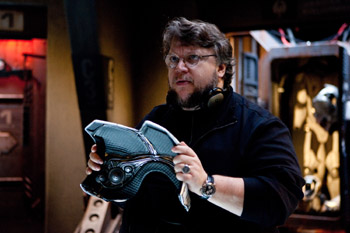 Director Guillermo del Toro on the set of PACIFIC RIM. Photo courtesy of Warner Bros. Pictures. © 2013 WARNER BROS. ENTERTAINMENT INC. AND LEGENDARY PICTURES FUNDING, LLC
Director Guillermo del Toro on the set of PACIFIC RIM. Photo courtesy of Warner Bros. Pictures. © 2013 WARNER BROS. ENTERTAINMENT INC. AND LEGENDARY PICTURES FUNDING, LLCDel Toro first gained worldwide recognition for the 1993 Mexican-American co-production “Cronos,” a supernatural horror film, which he directed from his own screenplay. The film premiered at the 1993 Cannes Film Festival, where it won the Mercedes Benz Award. It also won over twenty International awards, including eight Ariel Awards from the Mexican Academy of Film, including Best Director, Best Screenplay and the Golden Ariel. He then directed and co-wrote the supernatural thriller “The Devil’s Backbone,” which, along with "Cronos" has appeared repeatedly in Top Ten lists of best genre films of all times. In 2004, del Toro directed and co-wrote the action adventure sci-fi thriller “Hellboy,” starring Ron Perlman in the title role. Four years later, he wrote and directed the hit sequel, “Hellboy II: The Golden Army.” Among his other film credits, del Toro co-wrote and produced the gothic horror film “Don’t be Afraid of the Dark,” and served as an executive producer on the sci-fi horror thriller “Splice” and the supernatural thriller “The Orphanage,” which became the highest-grossing local language film in Spain’s history. In addition, he partnered with fellow Mexican directors Alfonso Cuarón and Alejandro González Iñárritu to produce “Rudo Y Cursi,” directed by Carlos Cuarón, and “Biutiful,” written and directed by Iñárritu. On the animation front, del Toro was an executive producer on the films “Kung Fu Panda 2,” “Puss in Boots” and “Rise of the Guardians.” Del Toro more recently executive produced the world-wide horror hit “Mama,” starring Jessica Chastain. Del Toro has also turned his attention to publishing. With novelist Chuck Hogan, he co-authored the horror novel The Strain, which was published in June 2009 by William Morrow. They have since collaborated on the books The Fall and The Night Eternal. All three books debuted as The New York Times top ten bestsellers. Del Toro is currently developing the Strain novels as an acclaimed series of graphic novels for Dark Horse comics and a television series for FX network. TRAVIS BEACHAM (Screenwriter) co-wrote the screenplay for the 2010 mythic adventure “Clash of the Titans,” directed by Louis Leterrier and starring Sam Worthington, Liam Neeson and Ralph Fiennes. A global mega hit, the film grossed more than 493 million dollars worldwide. Currently, Beacham is writing and executive producing a new sci-fi drama series entitled “Ballistic City,” which just sold to AMC. In addition, he is working on the screenplay for the feature “20,000 Leagues Under the Sea: Captain Nemo.” His upcoming projects also include a remake of the science fiction feature “The Black Hole.” Beacham sold his first spec script, “A Killing on Carnival Row,” in 2005, shortly after graduating from the University of North Carolina School of the Arts. He has also scripted several short films, including “Booth” about the assassination of Abraham Lincoln.
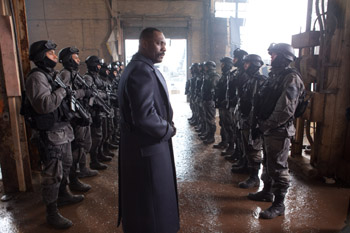 Idris Elba as Stacker Pentecost. Photo courtesy of Warner Bros. Pictures. © 2013 WARNER BROS. ENTERTAINMENT INC. AND LEGENDARY PICTURES FUNDING, LLC
Idris Elba as Stacker Pentecost. Photo courtesy of Warner Bros. Pictures. © 2013 WARNER BROS. ENTERTAINMENT INC. AND LEGENDARY PICTURES FUNDING, LLCTHOMAS TULL (Producer) is Chairman and CEO of Legendary Pictures and has achieved great success in the co-production and co-financing of event movies. Since its inception in 2004, Legendary Pictures, a division of leading media company Legendary Entertainment, with film and comics divisions, has teamed with Warner Bros. Pictures on a wide range of theatrical features. The many hits released under their joint banner include Christopher Nolan’s blockbuster Dark Knight trilogy, which kicked off with “Batman Begins,” followed by the award-winning phenomenon “The Dark Knight,” which earned in excess of a billion dollars worldwide. Nolan brought the story to an epic conclusion in 2012 with “The Dark Knight Rises,” which earned more than a billion dollars at the global box office. This highly successful partnership has also produced such films as Zack Snyder’s “300” and “Watchmen”; Ben Affleck’s “The Town”; Nolan’s award-winning action drama “Inception”; and the worldwide hit “Clash of the Titans” and its sequel, “Wrath of the Titans.” Warner Bros. and Legendary most recently released Zack Snyder’s “Man of Steel,” and concluded Todd Phillips’ “Hangover” trilogy with “The Hangover Part III.” The second film, “The Hangover Part II,” still ranks as the highest-grossing R-rated comedy of all time. They also scored a hit this year with Brian Helgeland’s real-life drama “42,” about the baseball legend Jackie Robinson. The company’s upcoming films include Sergei Bodrov’s “Seventh Son,” starring Jeff Bridges; “300: Rise of an Empire,” the new chapter in the “300” saga, opening March 7, 2014; “Godzilla,” being directed by Gareth Edwards and slated for May 2014, and “Gravel.” Before forming Legendary, Tull was President of The Convex Group, a media and entertainment holding company headquartered in Atlanta, on whose Board of Directors he also served. Tull is also a member of the Board of Trustees of the American Film Institute (AFI) and the Board of Directors of Hamilton College, his alma mater, and Carnegie Mellon University. He serves on the board of the San Diego Zoo and is a minority partner in the six-time Super Bowl champion Pittsburgh Steelers. JON JASHNI (Producer) oversees the development and production of all Legendary Pictures film projects and is President and Chief Creative Officer of Legendary Entertainment, a leading media company with film and comics divisions. Jashni is currently producing “Godzilla,” bringing the movie monster back to the screen in Summer 2014. He is also an executive producer on the upcoming “Seventh Son,” as well as the much-anticipated sequel “300: Rise of an Empire.” He previously served as executive producer on such Legendary hits as “Wrath of the Titans,” which was the follow-up to the worldwide hit “Clash of the Titans,” and “The Town,” directed by and starring Ben Affleck. Prior to Legendary, Jashni was President of Hyde Park Entertainment, a production and financing company with overall deals at 20th Century Fox, Disney and MGM. While there, he oversaw the development and production of “Shopgirl,” “Dreamer: Inspired by a True Story,” “Walking Tall” and “Premonition.” Before joining Hyde Park, Jashni was a producer on director Andy Tennant’s romantic comedy hit “Sweet Home Alabama.” Jashni’s collaboration with Tennant began with the fairytale “Ever After,” for which Jashni oversaw development and production as a senior production executive at 20th Century Fox. Jashni also co-produced two Academy Award®-nominated films: the critically acclaimed drama “The Hurricane,” which garnered a Best Actor nod for star Denzel Washington; and a non-musical reinterpretation of “Anna and the King,” which starred Jodie Foster and earned two Oscar nominations. Jashni is a member of the American Film Institute and the Producers Guild of America. He holds a BS from the University of Southern California and an MBA from UCLA’s Anderson School of Management.
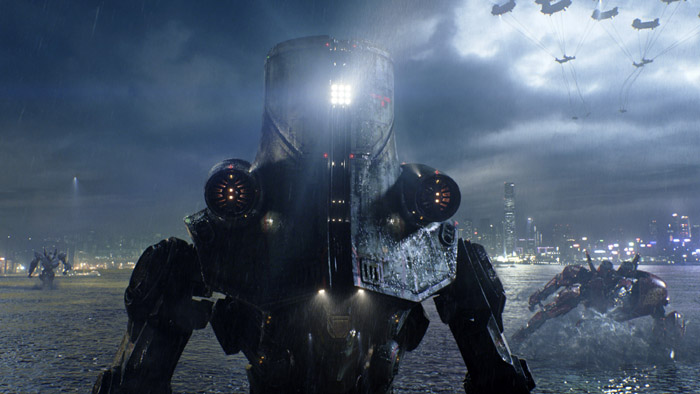 Russia`s Cherno Alpha. Photo courtesy of Warner Bros. Pictures. © 2013 WARNER BROS. ENTERTAINMENT INC. AND LEGENDARY PICTURES FUNDING, LLC
Russia`s Cherno Alpha. Photo courtesy of Warner Bros. Pictures. © 2013 WARNER BROS. ENTERTAINMENT INC. AND LEGENDARY PICTURES FUNDING, LLCMARY PARENT (Producer) is the founder and CEO of Disruption Entertainment, which has been based at Paramount since April 2011. Since starting the company, Parent has generated development of a diverse slate of films. Her upcoming films include the epic biblical drama “Noah,” directed by Darren Aronofsky and starring Russell Crowe, due out March 28, 2014; “Defending Jacob,” based on the best-selling novel by William Landay, to be scripted and directed by Steve Kloves; and the “SpongeBob SquarePants” sequel. Parent is also currently producing “Godzilla,” the rebirth of Toho’s famous movie monster, being directed by Gareth Edwards and set to be released on May 16, 2014. Previously, Parent was the CEO and Chairman of Metro-Goldwyn-Mayer’s Motion Picture Group, overseeing production, distribution and marketing for MGM and United Artists. Taking the reins at the studio in March 2008, Parent and her team assembled a development slate that included a new James Bond film; the film adaptation of “The Hobbit”; Drew Goddard’s “The Cabin in the Woods”; the sleeper hit “Hot Tub Time Machine,” starring John Cusack; “Zookeeper,” starring Kevin James; and “Red Dawn,” starring Chris Hemsworth and Josh Hutcherson. Prior to MGM, Parent co-founded Stuber/Parent, which produced its first five films in just two years, grossing more than $550 million, combined, at the box office. She had previously been Vice Chairman of Worldwide Production for Universal Pictures. She had joined Universal in 1997 as Senior Vice President of Production, moving up to President in 2000 before being named Vice Chairman in 2003. During her tenure at the studio, she oversaw such wide-ranging hits as Peter Jackson’s “King Kong”; “The 40-Year-Old Virgin”; “Meet the Parents” and its sequel “Meet the Fockers”; “The Bourne Identity” and “The Bourne Supremacy”; “The Fast and the Furious”; “Along Came Polly”; the Oscar-nominated “Seabiscuit”; “American Wedding”; Ang Lee’s “Hulk”; “8 Mile”; “Red Dragon”; “Jurassic Park III”; “Bridget Jones’s Diary”; “Hannibal”; “Dr. Seuss’ How the Grinch Stole Christmas”; and the Academy Award®-winning “Gladiator,” a co-production with DreamWorks. Parent came to Universal from New Line Cinema, where she had been a creative executive and then Vice President of Production. While there, she also executive produced the films “Pleasantville” and “Set It Off.” She began her career as an agent trainee at ICM.
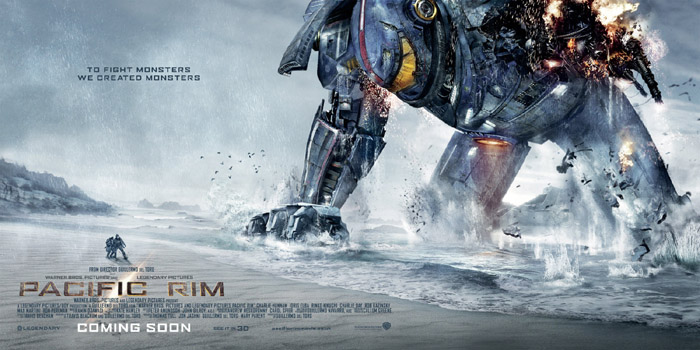 Image courtesy of Warner Bros. Pictures. © 2013 WARNER BROS. ENTERTAINMENT INC. AND LEGENDARY PICTURES FUNDING, LLC
Image courtesy of Warner Bros. Pictures. © 2013 WARNER BROS. ENTERTAINMENT INC. AND LEGENDARY PICTURES FUNDING, LLCCALLUM GREENE (Executive Producer) has worked as a producer and unit production manager (UPM) on a diverse list of independent and major studio films. He is currently reunited with Guillermo del Toro on the thriller “Crimson Peak.” In 2004, Greene received dual Independent Spirit Award nominations, as a producer on the films “Happy Here and Now” and “Homework.” His more recent credits include serving as an executive producer on “Everybody’s Fine,” “Made of Honor” and “Vantage Point”; production manager on Emilio Estevez’s “Bobby”; and co-producer/UPM on Sofia Coppola’s “Marie Antoinette.” He previously worked with Coppola as a line producer on the award-winning “Lost in Translation.” Greene has also worked on such independents as “Thumbsucker,” “The Beautiful Country,” “Second Best,” “Nearest to Heaven” and “The Next Big Thing.” He was also a producer on the cable movies “Rudy: The Rudy Giuliani Story,” starring James Woods, and “3 A.M.,” starring Danny Glover. In addition, Greene has produced several documentaries, including “This So Called Disaster: Sam Shepard Directs The Late Henry Moss,” featuring Shepard, Sean Penn, Nick Nolte and Woody Harrelson, and director Mike Mills’ “Does Your Soul Have a Cold,” for IFC TV. Greene had already worked in Europe as a theatrical producer and stage manager when he enrolled in the Masters program at Columbia University, where he was awarded the Arthur Krim Fellowship. He went on to serve as a co-producer on such features as “Long Time Since,” “The Farmhouse” and “In the Weeds,” as well as line-producing “Better Living,” “Hostage” and Michael Almereyda’s “Hamlet.” GUILLERMO NAVARRO (Director of Photography) won an Academy Award® for Best Cinematography for “Pan’s Labyrinth,” directed by Guillermo del Toro. His work on that film also brought Navarro an Independent Spirit Award, an Ariel Award from Mexico’s Academy of Film, and a New York Film Critics Circle Award, as well as a BAFTA Award nomination. Navarro first collaborated with del Toro on “Cronos,” and they also teamed on the director’s films “The Devil’s Backbone,” “Hellboy” and Hellboy II: The Golden Army.” Navarro more recently lensed D.J. Caruso’s “I Am Number Four” and the blockbuster “Twilight” installments “The Twilight Saga: Breaking Dawn – Parts 1 and 2.”
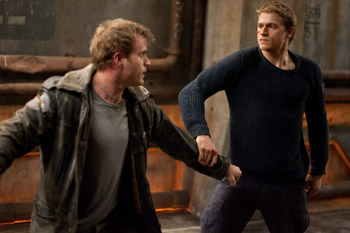 Rob Kazinsky as Chuck Hansen and Charlie Hunnam as Raleigh Becket. Photo courtesy of Warner Bros. Pictures. © 2013 WARNER BROS. ENTERTAINMENT INC. AND LEGENDARY PICTURES FUNDING, LLC
Rob Kazinsky as Chuck Hansen and Charlie Hunnam as Raleigh Becket. Photo courtesy of Warner Bros. Pictures. © 2013 WARNER BROS. ENTERTAINMENT INC. AND LEGENDARY PICTURES FUNDING, LLCHailing from Mexico, Navarro has also served as cinematographer on several films by another compatriot, Robert Rodriguez, including “Spy Kids,” “From Dusk Till Dawn” and Rodriguez’s segment of “Four Rooms.” Navarro’s film credits also include Shawn Levy’s “Night at the Museum,” Jon Favreau’s “Zathura: A Space Adventure,” Rob Minkoff’s “Stuart Little,” Quentin Tarantino’s “Jackie Brown,” Mark Dippé’s “Spawn,” and Renny Harlin’s “The Long Kiss Goodnight.” For television, Navarro made his directorial debut this year on the NBC series “Hannibal.” He also recently lensed Bryan Singer’s telefilm “Mockingbird Lane.” In 2011, the Latino International Film Festival honored Navarro with its GABI Lifetime Achievement Award. ANDREW NESKOROMNY (Production Designer) recently served as production designer on the sci-fi thriller “Apollo 18.” Neskoromny’s additional credits as a production designer include Zack Snyder’s film directorial debut, “Dawn of the Dead,” “Punisher: War Zone,” “Alien vs. Predator: Requiem,” “Slither,” and “Replicant.” Neskoromny also held the post of art director on such films as Justin Lin’s hit actioner “Fast Five”; “Battle Los Angeles”; the Jay Roach-directed features “Meet the Fockers” and “Mystery, Alaska”; Gary Ross’s Oscar®-nominated true-life drama “Seabiscuit,” for which he was nominated for an Art Directors Guild Award; Phil Alden Robinson’s “The Sum of All Fears”; Brian De Palma’s “Mission to Mars”; Bruce Beresford’s “Double Jeopardy”; Mimi Leder’s “Deep Impact”; and Jean-Pierre Jeunet’s “Alien: Resurrection.” Neskoromny began his career as a set designer on such films as “Coming to America,” “Star Trek V: The Final Frontier,” “Courage Under Fire,” “Matilda,” “Anaconda,” and “Gone Fishin’.” For the small screen, Neskoromny served as an art director on the series “Star Trek: The Next Generation” and “Star Trek: Voyager,” and as production designer on the miniseries “Masters of Science Fiction.” CAROL SPIER (Production Designer) most recently worked on Kimberly Peirce’s upcoming remake of the horror classic “Carrie,” set for release this fall. She has also had a long association with director David Cronenberg, for whom she has designed “Eastern Promises,” “A History of Violence,” “eXistenZ,” “Crash,” “M. Butterfly,” “Naked Lunch,” “Dead Ringers,” “The Fly” and “The Dead Zone.” Spier began her collaboration with Cronenberg by designing his films “Fast Company,” “The Brood,” “Scanners” and “Videodrome.” She more recently served as a visual consultant on his drama “A Dangerous Method.” Spier previously worked with Guillermo del Toro on “Blade II” and “Mimic.” Her long list of credits as a production designer also include “Passchendaele,” “Silent Hill,” “The League of Extraordinary Gentlemen,” “Dracula 2000,” “Joe’s Apartment,” “The Santa Clause” and “Consenting Adults.” Her early work as an art director includes the films “The Believers” and “Agnes of God.” A native of Canada, Spier has been honored with Directors Guild of Canada (DGC) Craft Awards for her work on both “Eastern Promises” and “Passchendaele,” and Genie Awards for the latter, as well as “Dead Ringers” and “Naked Lunch.” The DGC presented her with a Lifetime Achievement Award in 2009.
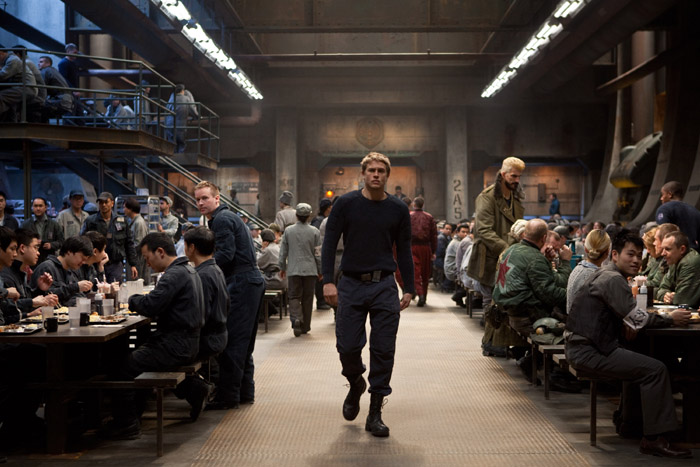 Charlie Hunnam as Raleigh Becket. Photo courtesy of Warner Bros. Pictures. © 2013 WARNER BROS. ENTERTAINMENT INC. AND LEGENDARY PICTURES FUNDING, LLC
Charlie Hunnam as Raleigh Becket. Photo courtesy of Warner Bros. Pictures. © 2013 WARNER BROS. ENTERTAINMENT INC. AND LEGENDARY PICTURES FUNDING, LLCPETER AMUNDSON (Editor) worked with Guillermo del Toro as the editor on “Hellboy” and “Blade II.” Amundson more recently edited Mike Mitchell’s family hit “Alvin and the Chipmunks: Chipwrecked” and previously teamed with Mitchell on the adventure “Sky High,” starring Kurt Russell. He has edited four films for director Rob Cohen: “The Skulls,” “Daylight,” “DragonHeart” and “Dragon: The Bruce Lee Story.” His other film credits include “Ironclad,” “Gamer,” “Shoot ‘Em Up,” “The Butterfly Effect,” and Roland Emmerich’s “Godzilla.” Amundson began his career at Industrial Light & Magic where he worked on “Star Wars: Episode VI – Return of the Jedi,” “Star Trek II: The Wrath of Kahn” and” Poltergeist” as visual effects editor. He also served as visual effects editor on the acclaimed true-life drama “The Right Stuff.” JOHN GILROY (Editor) recently edited the latest installment of the Bourne franchise, “The Bourne Legacy,” directed by his brother, Tony and starring Jeremy Renner and Rachel Weisz. John and his brother previously worked together on “Duplicity,” starring Julia Roberts and Clive Owen, and the Oscar-nominated “Michael Clayton,” starring George Clooney, for which John was nominated for a BAFTA Award and an A.C.E. Eddie Award. Gilroy has also frequently collaborated with director Gavin O’Connor, editing the films “Warrior,” “Pride and Glory,” “Miracle,” and the acclaimed independent film “Tumbleweeds.” He also edited Philip Noyce’s action thriller “Salt,” starring Angelina Jolie. In addition, Gilroy has worked several times with filmmaker Joe Carnahan, editing the police drama “Narc” and “Ticker,” a short film in BMW Films’ “The Hire” series. Gilroy won a CLIO Award for his work on the latter. His other editing credits include “Trust the Man,” “First Born,” “Suspect Zero,” “Shadow Magic,” and “Billy Madison.” Gilroy graduated Dartmouth College and came up through the editing ranks in the ‘80s. He worked as an assistant editor on numerous features, including two for Francis Ford Coppola, “Peggy Sue Got Married” and “Gardens of Stone.” His first editing credit was “The Luckiest Man in the World,” written and directed by his father, Frank D. Gilroy. KATE HAWLEY (Costume Designer) most recently completed work on the sci-fi action adventure “All You Need is Kill,” directed by Doug Liman and starring Tom Cruise and Emily Blunt. The film is slated for release in Summer 2014. She is currently working on “Crimson Peak,” for Guillermo del Toro. Hawley previously designed the costumes for the independent film “On a Clear Day,” which debuted at the 2005 Sundance Film Festival, and she served as an additional costume designer for the Peter Jackson-directed “The Hobbit” Trilogy and “The Lovely Bones.” She has designed extensively for the stage, including both theatre and opera productions. Her credits include “The Trial of the Cannibal Dog,” for the New Zealand International Arts Festival; “Luca Di Lammermoor,” at the NBR New Zealand Opera; “The Love of the Nightingale,” for the Western Australian Opera; “The Blonde, the Brunette and the Vengeful Redhead,” for the Auckland Theatre Company; “Alice in Wonderland,” at Venice, Italy’s The Danielli; “Blithe Spirit,” at the Salisbury Playhouse; and “La Boheme,” at the Wexford Opera Festival. Additionally, Hawley served as costume and production designer for “La Tete,” presented at the Royal National Theatre Studio and as production designer for “Albert Herring,” at the Aldeburgh Festival. Additionally, her designs have been featured in exhibitions in London and Prague.
 Charlie Hunnam as Raleigh Becket and Rinko Kikuchi as Mako Mori. Photo courtesy of Warner Bros. Pictures. © 2013 WARNER BROS. ENTERTAINMENT INC. AND LEGENDARY PICTURES FUNDING, LLC
Charlie Hunnam as Raleigh Becket and Rinko Kikuchi as Mako Mori. Photo courtesy of Warner Bros. Pictures. © 2013 WARNER BROS. ENTERTAINMENT INC. AND LEGENDARY PICTURES FUNDING, LLCHer awards include the Gold Key Award from the Bretislav Film Festival for the Channel 4/BBC production of “T DANCE”; the Queen Elizabeth II Arts Council Award for Opera Studies; the Prague Quadrennial 99 Award for Emerging Young Artists; and the Television New Zealand Young Achievers Award. Hawley earned a degree at the Wellington School of Design in New Zealand. She later attended London’s Motley School of Theatre Design and trained in stage drafting at the Royal Opera House in London. RAMIN DJAWADI (Composer) is a Grammy-nominated and two-time Emmy-nominated composer who has gained acclaim for his melodic and thematic scores. His music varies widely from classical orchestral pieces to electronic and modern compositions. Djawadi (pronounced Javadi) is the composer behind the music for HBO’s hit series “Game of Thrones,” creating the show’s main title theme as well as the underscore for all three seasons. The series was recently renewed for a fourth season. This fall, he will return to work on CBS’s “Person of Interest” to score the third season of Jonathan Nolan’s popular series. He previously scored A&E’s “Breakout Kings”; ABC’s “FlashForward,” for which he received an Emmy nomination for Outstanding Music Composition for a Series; and FOX’s “Prison Break,” for which he earned his first Emmy nomination, for Outstanding Main Title Music. Djawadi has also been recognized for his Grammy-nominated, guitar-driven score for the blockbuster “Iron Man.” He has since composed the music for such films as “Safe House,” “Fright Night,” “Clash of the Titans” and “Red Dawn.” He earlier created the ethereal score for the film “Mr. Brooks,” which earned him a World Soundtrack Award nomination for Discovery of the Year. Djawadi has collaborated frequently with writer David Goyer on several film and television projects, including “Blade: Trinity,” on which he worked with The RZA; the horror thriller “The Unborn,” produced by Michael Bay; and the aforementioned series “FlashForward.” In the world of animated films, he scored the first Sony Animation project, “Open Season,” followed by “Open Season 2.” His work on those films attracted the attention of the filmmakers at the Belgium-based NWave, who created one of the first animated movies in 3D, “Fly Me to the Moon,” as well as “Sammy’s Adventure,” both scored by Djawadi. Before stepping out on his own, Djawadi was mentored by Oscar®-winning composer Hans Zimmer. Developing his own signature sound, Djawadi composed additional music for such films as “The Time Machine”; “Basic”; “The Recruit”; the blockbuster “Pirates of the Caribbean: The Curse of the Black Pearl”; Nancy Meyer’s “Something’s Gotta Give”; and “Batman Begins,” for director Christopher Nolan. He then collaborated with Zimmer to co-compose and produce the score for the family action adventure “Thunderbirds.”
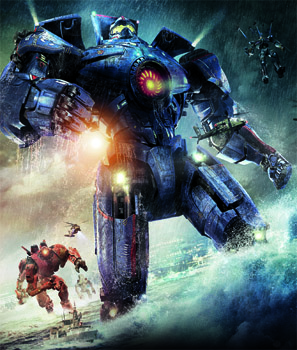 Textless promotional artwork, courtesy of Warner Bros. Pictures. © 2013 WARNER BROS. ENTERTAINMENT INC. AND LEGENDARY PICTURES FUNDING, LLC
Textless promotional artwork, courtesy of Warner Bros. Pictures. © 2013 WARNER BROS. ENTERTAINMENT INC. AND LEGENDARY PICTURES FUNDING, LLCGrowing up in Germany, Djawadi developed an early appreciation for classical music that then expanded to rock and jazz. He graduated summa cum laude from the Berklee College of Music. JOHN KNOLL (Visual Effects Supervisor) is Chief Creative Officer, in addition to being a visual effects supervisor, at Industrial Light & Magic (ILM). A five-time Academy Award® nominee, he garnered his most recent Oscar® nods, as well as three BAFTA nominations, for his VFX work on three “Pirates of the Caribbean” movies: “The Curse of the Black Pearl,” “Dead Man’s Chest” and “At World’s End.” He was previously Oscar®-nominated for “Star Wars: Episode I – The Phantom Menace,” also receiving a BAFTA Award nomination, and “Star Wars: Episode II – Attack of the Clones.” He is one of the industry’s most sought-after supervisors, whose resume also includes Brad Bird’s “Mission: Impossible – Ghost Protocol,” Martin Scorsese’s “Hugo,” Gore Verbinski’s “Rango,” James Cameron’s “Avatar,” “Star Wars: Episode III - Revenge of the Sith,” “Mission to Mars” and “Deep Blue Sea,” among others. Knoll’s interest in filmmaking and visual effects began at an early age, after being mesmerized by the original “Star Wars” and then having the opportunity to visit ILM in 1978. Inspired to learn more, he attended the USC School of Cinema and earned a BA in Cinema Production, while freelancing as a model maker at a variety of Los Angeles-based production facilities. During his last year at USC, Knoll took an advanced animation class, where he built a motion control system from an Oxberry animation stand, an Apple II computer, a CNC milling machine controller, and a bunch of industrial surplus stepper motors. Impressed by the student film that was generated from this class project, ILM hired Knoll as a technical assistant for motion control photography in 1986. He was soon promoted to motion control camera operator for “Captain EO.” After three years of operating, Knoll was called upon to work on the groundbreaking digital effects for “The Abyss.” He was then promoted to visual effects supervisor, and has since helmed the VFX on more than 20 feature films and commercials. In addition to his film work, Knoll teamed up with his brother, who was working on his doctoral thesis in computer vision at the University of Michigan, and created Photoshop in 1987. JAMES E. PRICE (Visual Effects Supervisor) has worked on the visual effects for a wide range of films. He previously served as visual effects supervisor on such titles as Joe Carnahan’s “The A-Team,” Baz Luhrmann’s “Australia,” Catherine Hardwicke’s “The Nativity Story,” Simon Wells’ “The Time Machine,” Jon Turteltaub’s “The Kid,” Chris Columbus’ “Bicentennial Man” and Tony Scott’s “Enemy of the State.” Additionally, he was the visual effects supervisor and second unit director on “The Seeker: The Dark is Rising” and “Son of the Mask.” Price started out in digital effects on Steven Spielberg’s “Hook,” and went on to be the digital effects supervisor on “Waterworld” and “Down Periscope.” He also worked as a visual effects supervisor for Boss Film Studios on “Air Force One,” and as a visual effects plate supervisor for Weta Digital on “The Lord of the Rings: The Two Towers.”
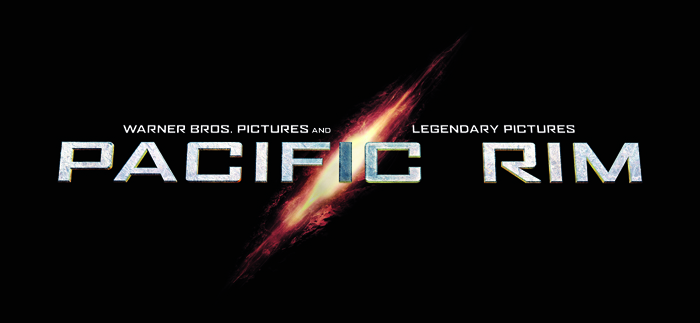 Logo courtesy of Warner Bros. Pictures. © 2013 WARNER BROS. ENTERTAINMENT INC. AND LEGENDARY PICTURES FUNDING, LLC
Logo courtesy of Warner Bros. Pictures. © 2013 WARNER BROS. ENTERTAINMENT INC. AND LEGENDARY PICTURES FUNDING, LLCFor more information on PACIFIC RIM, please see the earlier coverage here on SciFi Japan:
- Legendary Pictures Previews GODZILLA and PACIFIC RIM at Comic-Con
- Warner Bros. Previews PACIFIC RIM
- Japanese Trailer and Images for PACIFIC RIM

